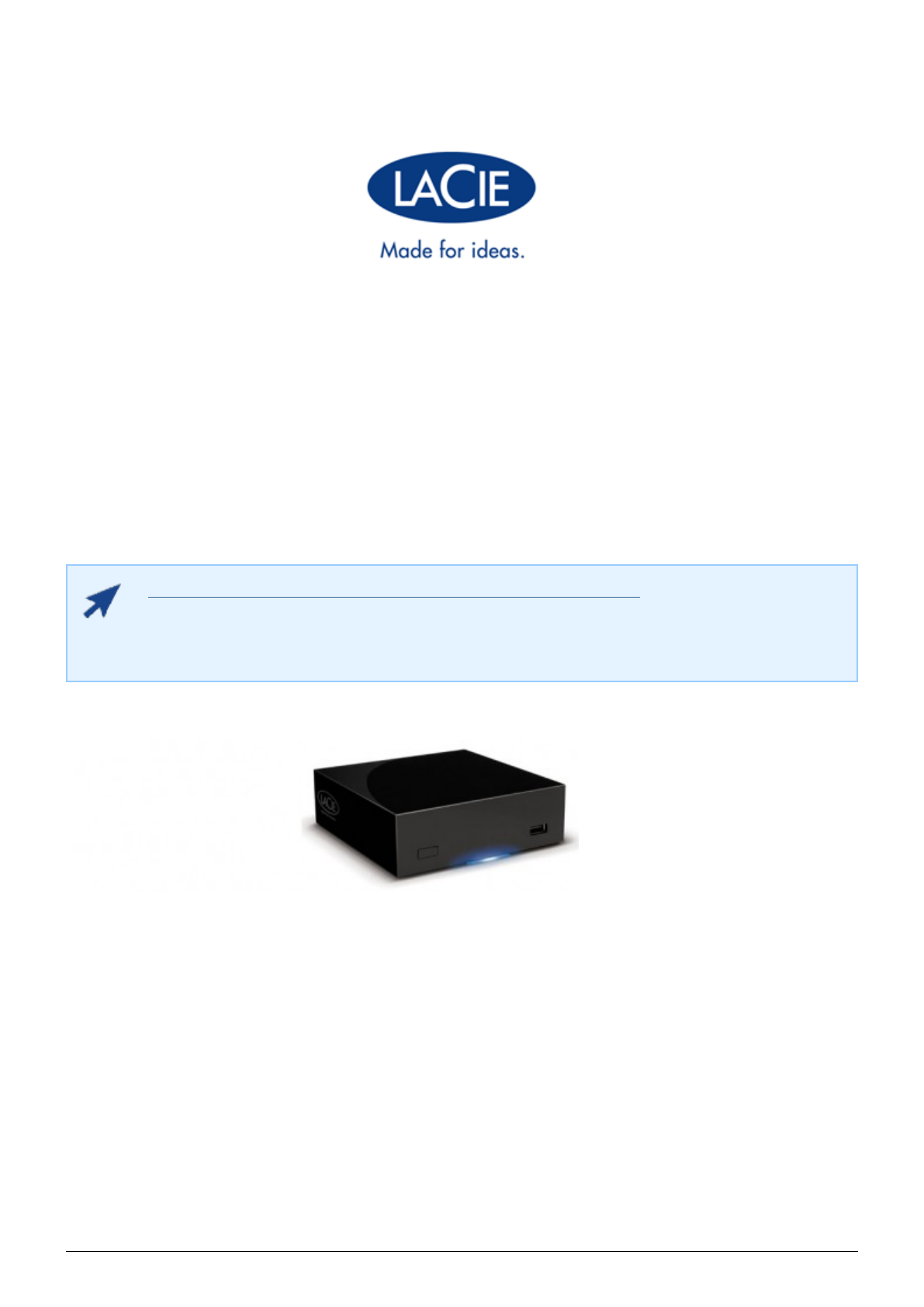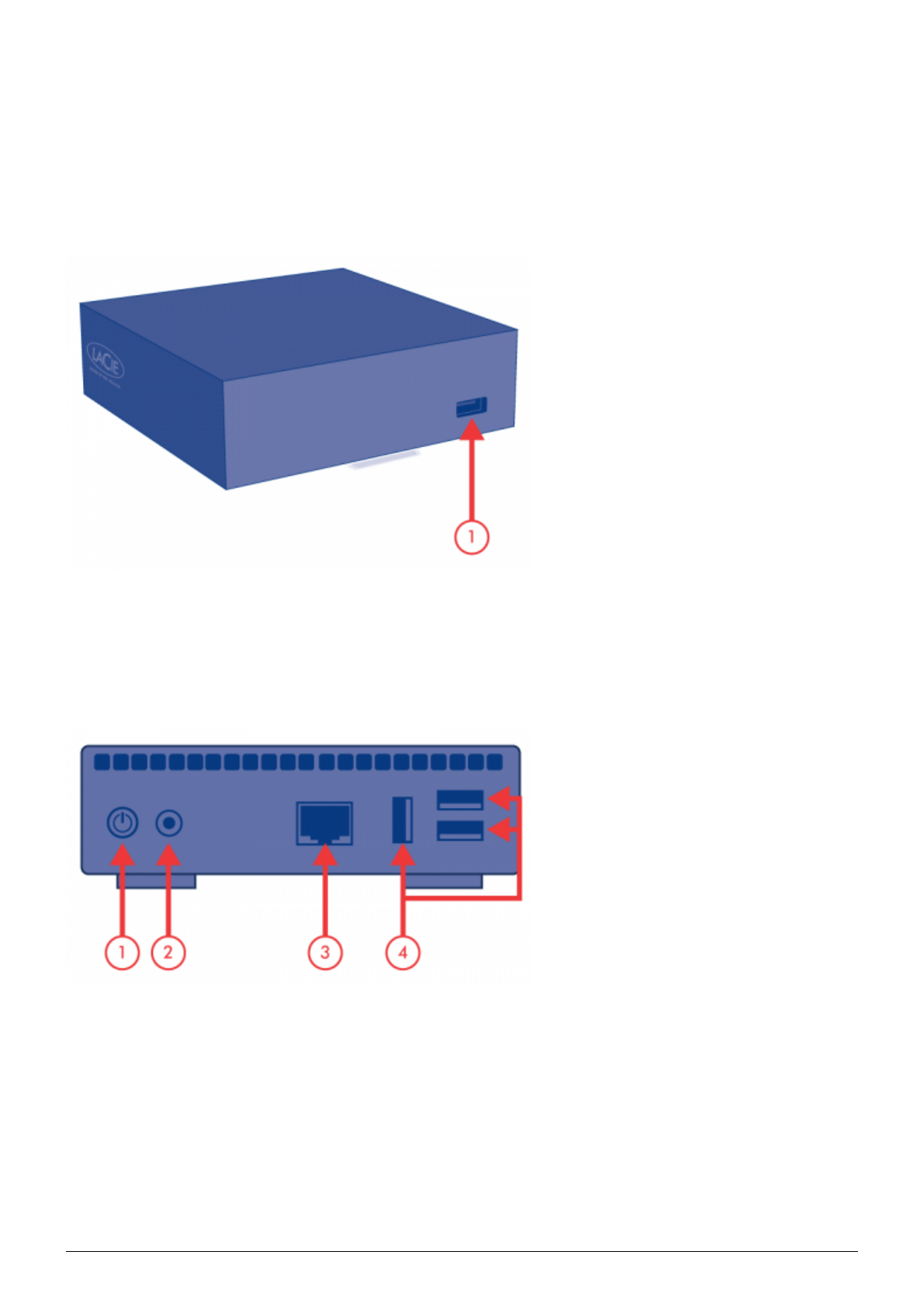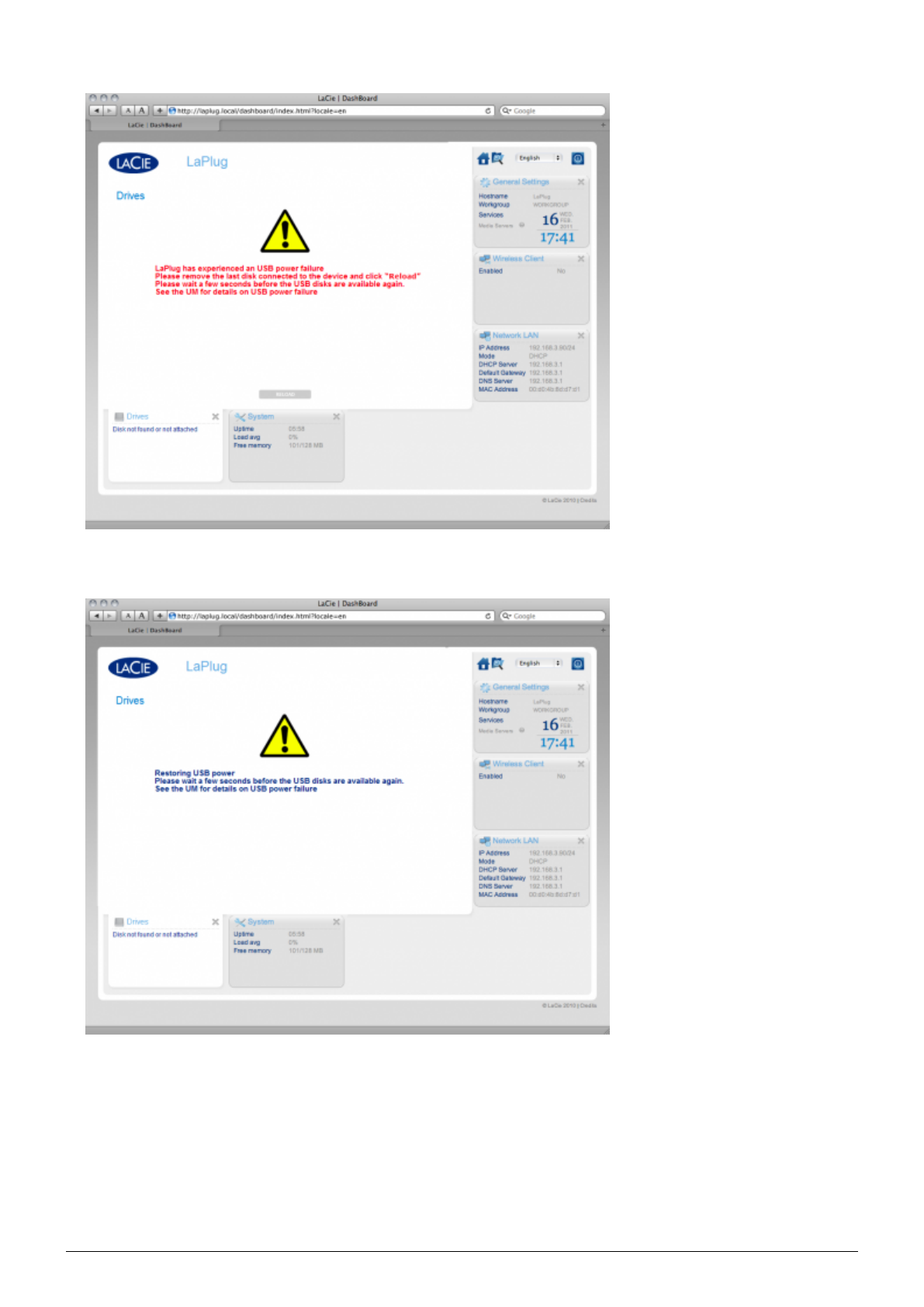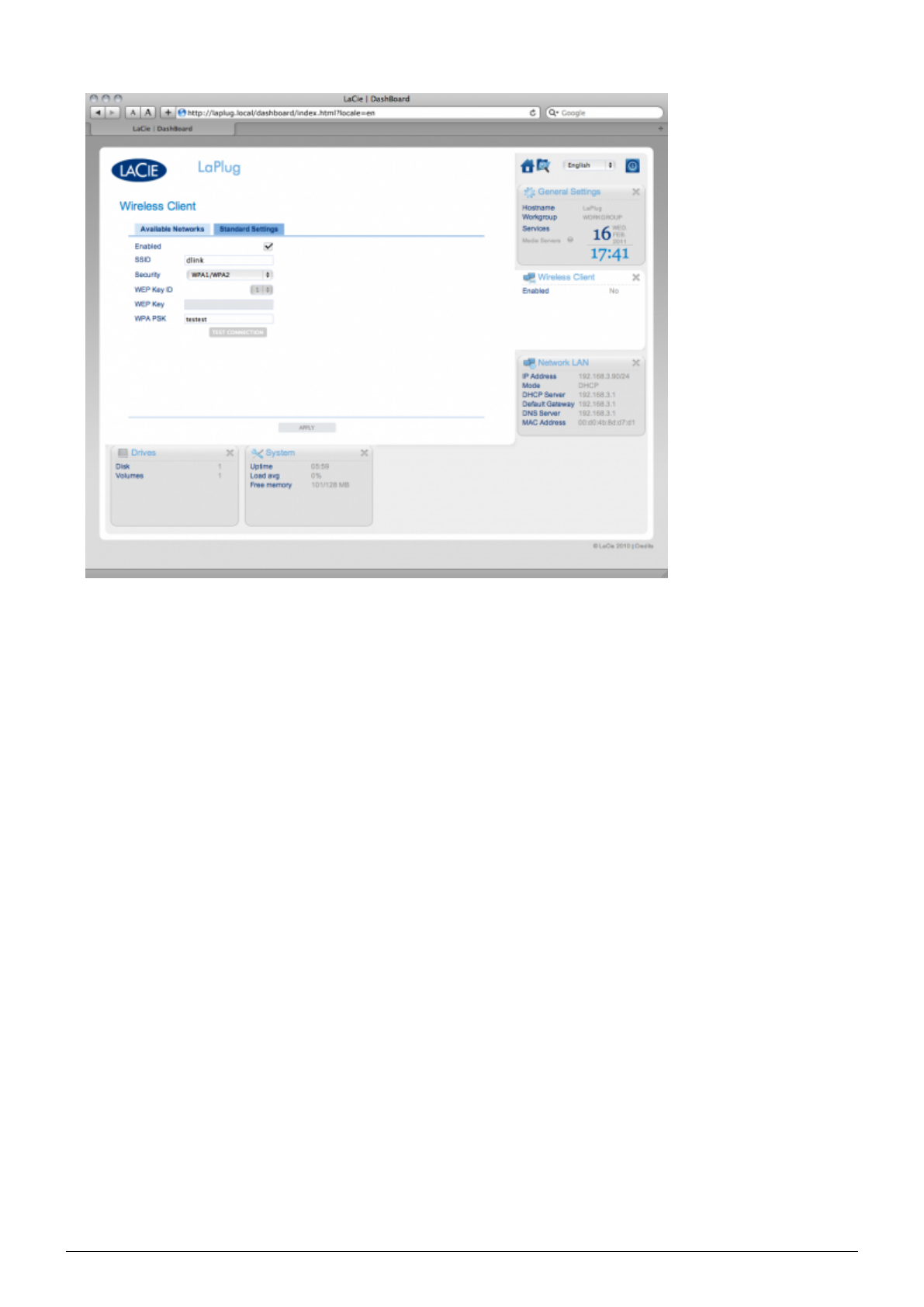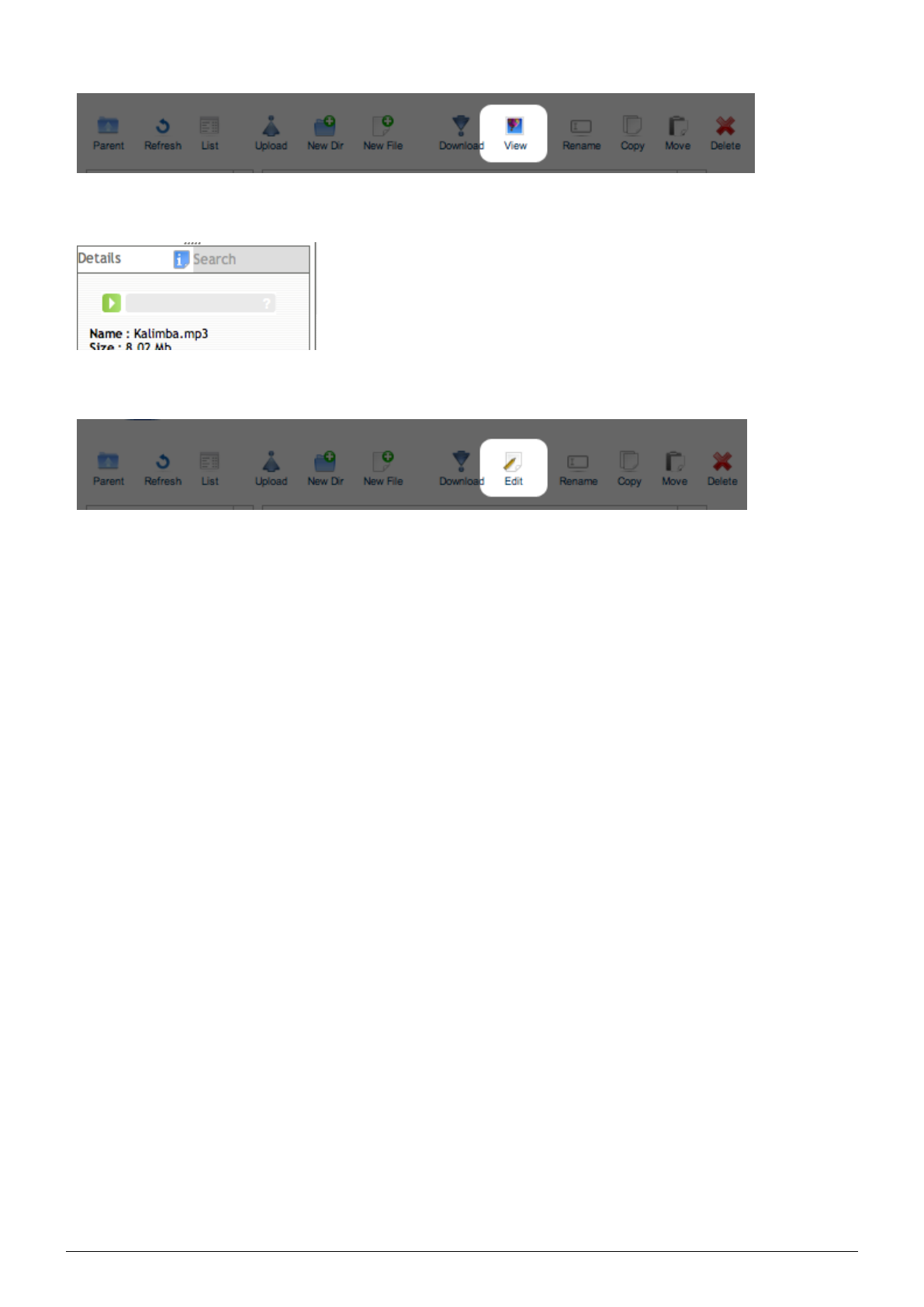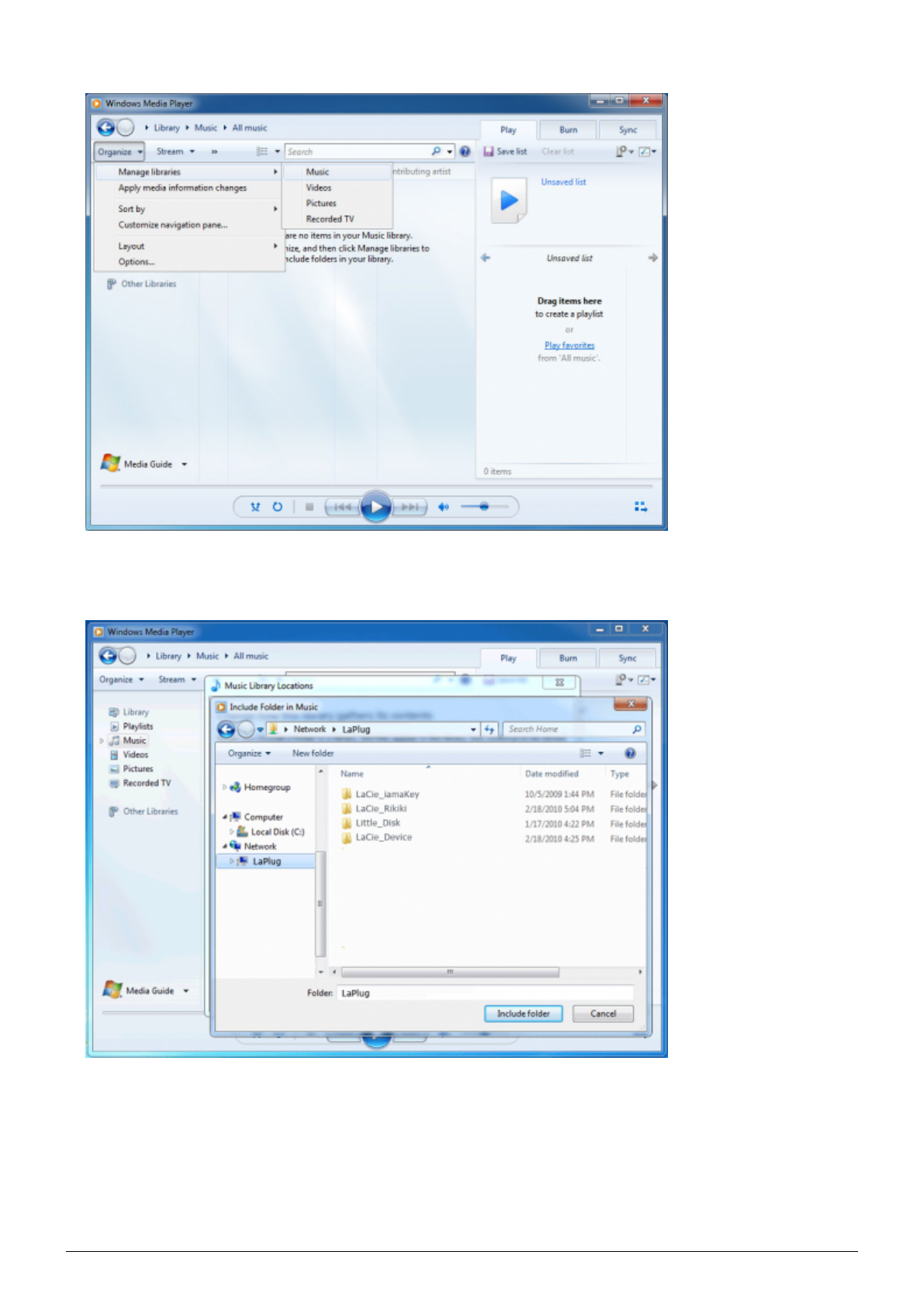GemTek Technology LP1 Laplug User Manual LaPlug
Gemtek Technology Co., Ltd. Laplug LaPlug
UserMan_MXF-LP1

INTRODUCTION
Congratulations on your purchase of a LaPlug. This cutting-edge media adapter will
allow you to bring your existing storage devices onto the network, making stored
files available throughout the house.
This manual will guide you through the process of connecting your LaCie product to your network and will assist
you in troubleshooting any issues that might arise. If you encounter problems, check Getting Help. Note that
most user problems can be resolved by resetting the product to factory conditions (see Update Product
Software).
BOX CONTENT
Computer with an Ethernet network adapter
■
Latest version of Windows® XP, Windows Vista®, Windows 7/ Mac® OS X 10.5, 10.6 / Linux 2.6
■
Minimum free disk space: 600MB recommended
■
Ethernet switch or router
■
Wi-Fi access point for wireless connection
■
Web browsers: Internet Explorer® 7.0, Firefox® 3.0, Safari® 3.0, or Chrome 2.0 or higher
■
USB external hard disk or USB key
■
Important info: Please save your packaging. In the event that the drive should need to be repaired or
serviced, it must be returned in its original packaging.
MINIMUM SYSTEM REQUIREMENTS
Computer with a USB port and Ethernet network adapter
■
Latest version of Windows® XP; Windows Vista®, Windows 7 / Mac® OS X 10.5, 10.6 / Linux 2.6
■
Minimum free disk space: 600MB recommended
■
Ethernet switch or router 10/100/1000Mbits
■
Web browsers: Internet Explorer® 7.0, Firefox® 3.0, Safari® 3.0, or Chrome 2.0 or higher
■
LaPlug User Manual LaCie 2
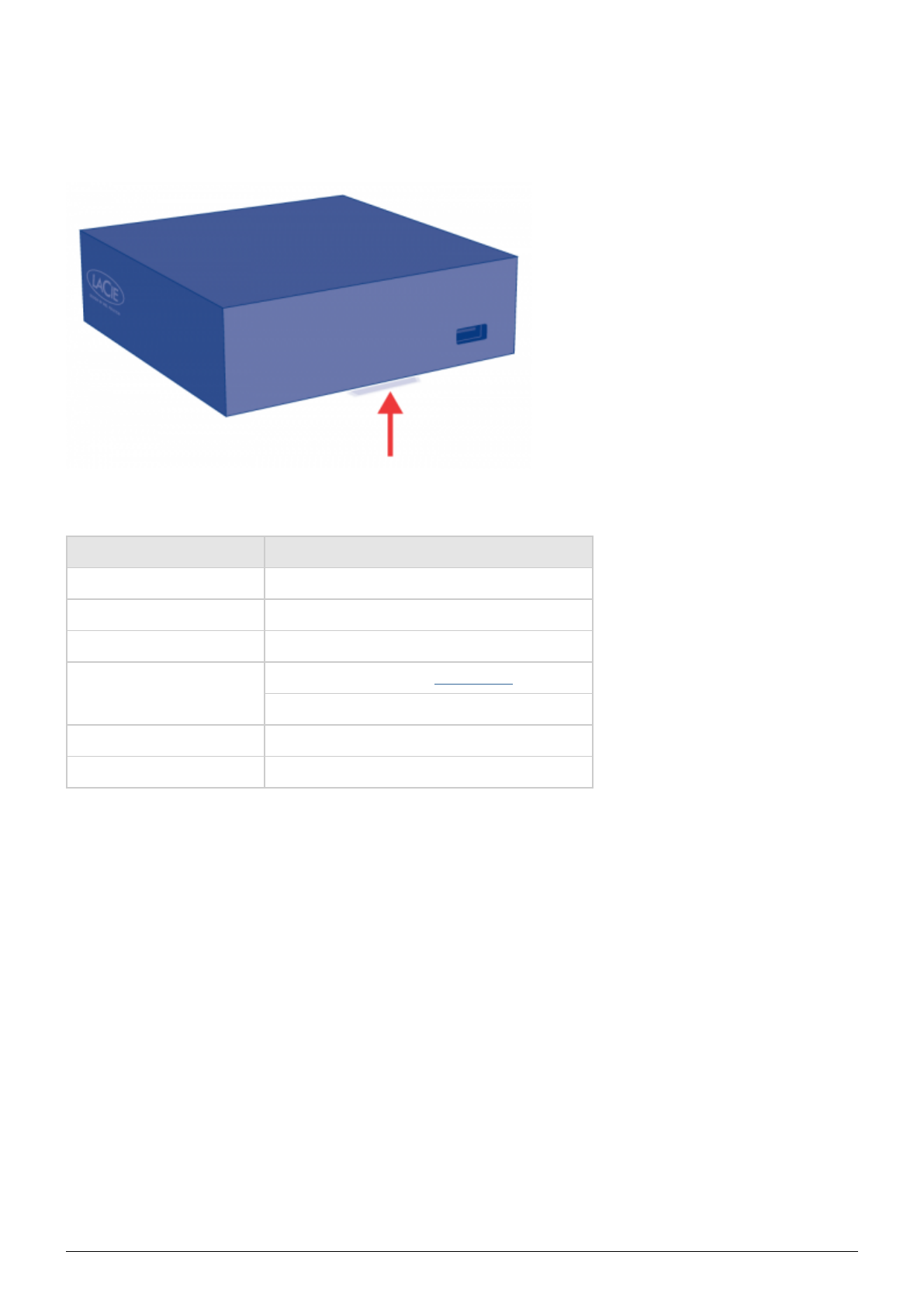
LED BEHAVIOR
The front LED changes to indicate different drive behavior. The following table sums up these behaviors.
State Indication
Solid blue Product is idle
Slow blinking blue Product is starting up
Solid red System is shutting down
Slow blinking red USB power failure (see Installation)
Firmware upgrade failure
Slow blinking blue and red WiFi enabled but not connected to a network
Fast blinking blue and red Firmware upgrade in process
LaPlug User Manual LaCie 4
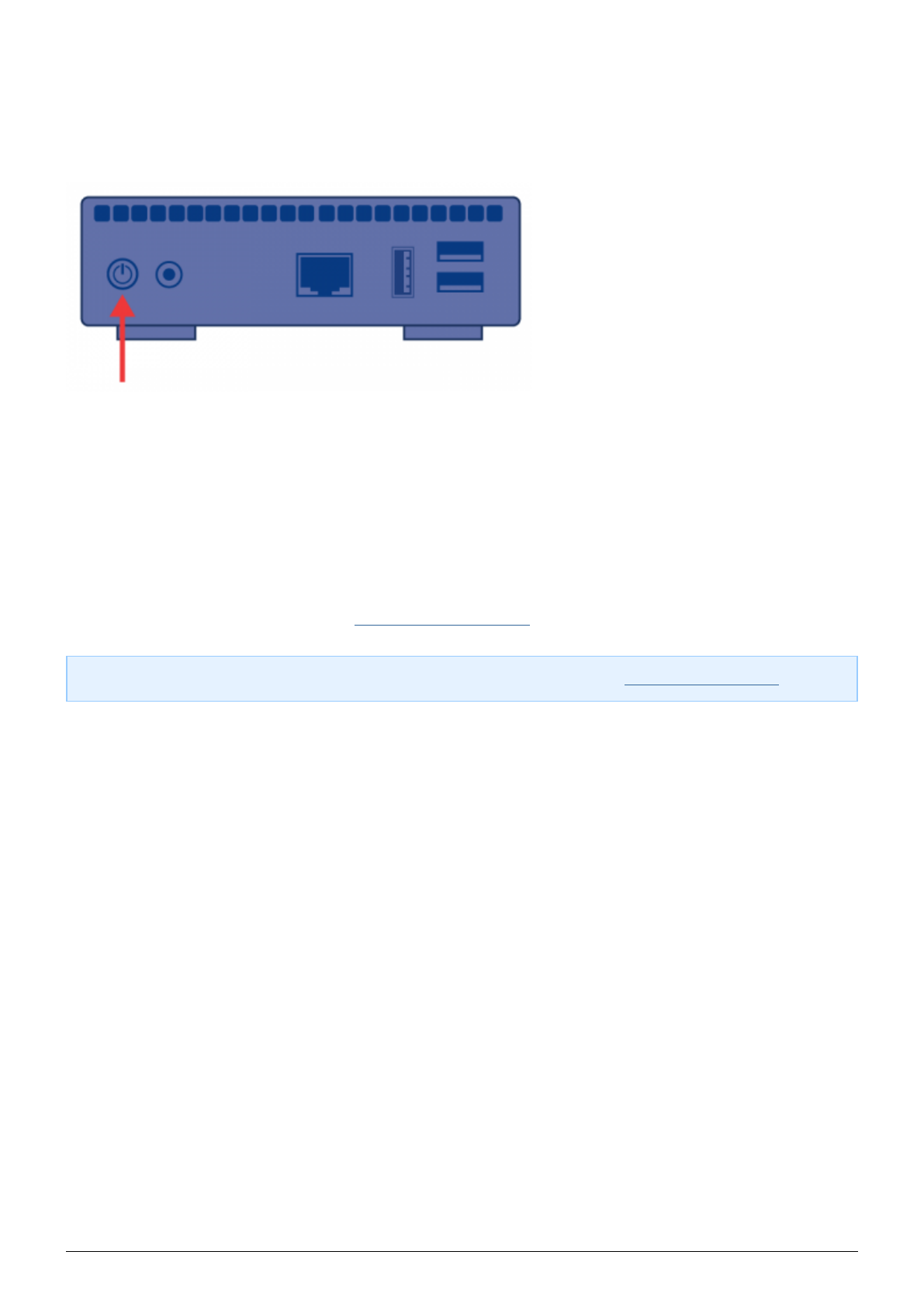
POWER BUTTON FUNCTIONS
Turn the product on: Push the power button until the front LED turns blue. Release the button and the LED
■
will flash blue. Then the product will boot, which may take up to two minutes. When the light becomes steady
blue, the product is ready to use.
Turn the product off: Press and hold the power button until the light slowly flashes blue. The product will
■
then:
Stop file transfers
■
Unmount volumes
■
Shut down
■
Restore Default Configuration: See Update Product Software.
■
Note: Another way to turn the product on or off is to use the Dashboard (see Administer the LaPlug).
LaPlug User Manual LaCie 5
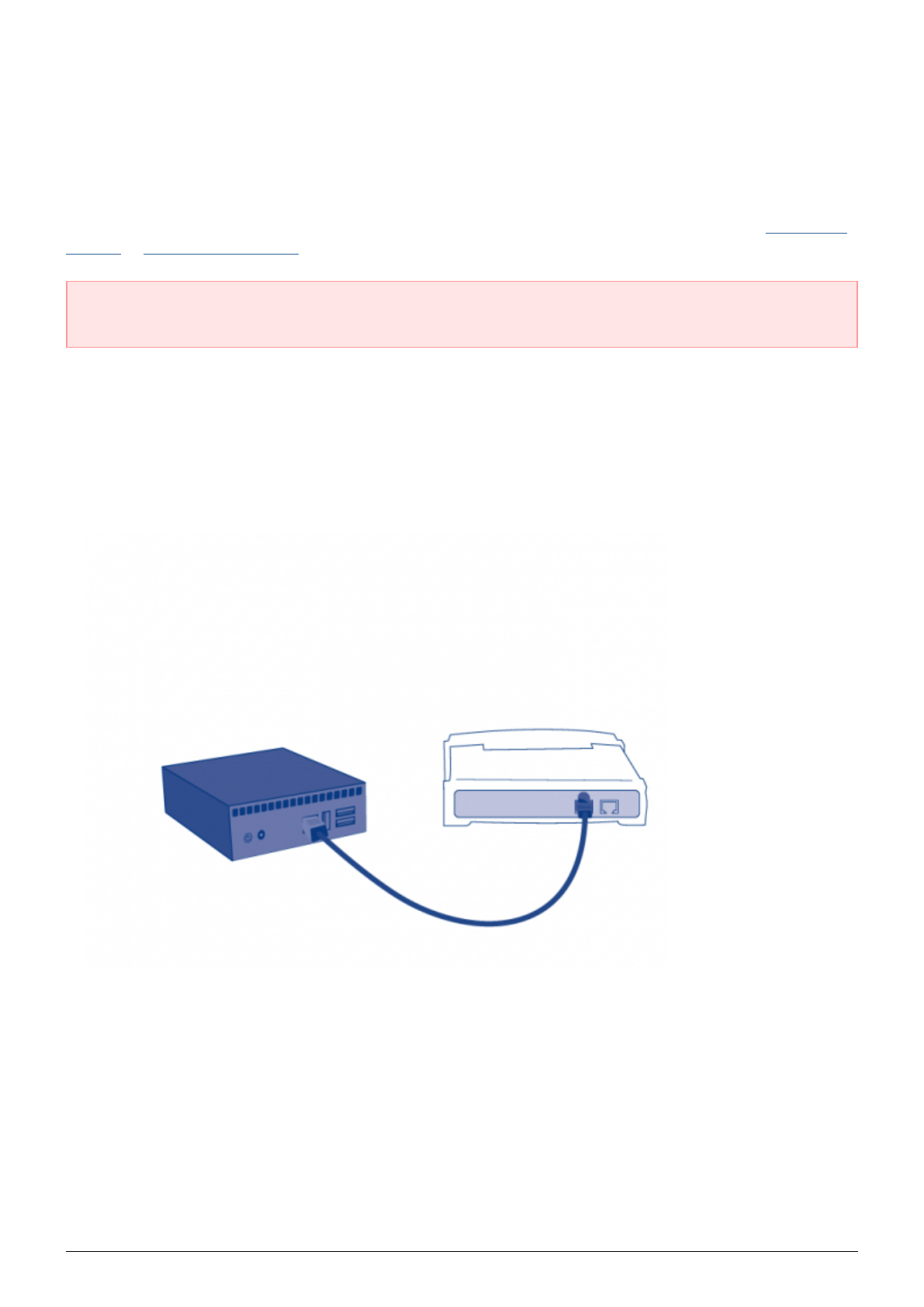
INSTALLATION
This chapter explains how to connect your LaPlug to your network. Simply install LaCie Network Assistant, a
small utility which will help you to discover and configure your product, then connect the LaPlug to the network.
Follow the steps below to get your product up and running. After you finish installation, move on to Access USB
Devices or Administer the LaPlug.
Important info: Even if you intend to connect to the LaPlug using Wi-Fi, you must first connect it to your
network via the Ethernet cable in order to configure the wireless connection.
1 - CONNECT THE ETHERNET CABLE
Connect the Ethernet cable to the Ethernet port on the back of the product.1.
Connect the other end of the Ethernet cable into an available Ethernet port on your router or hub (refer to2.
your router or hub's documentation if necessary).
LaPlug User Manual LaCie 6
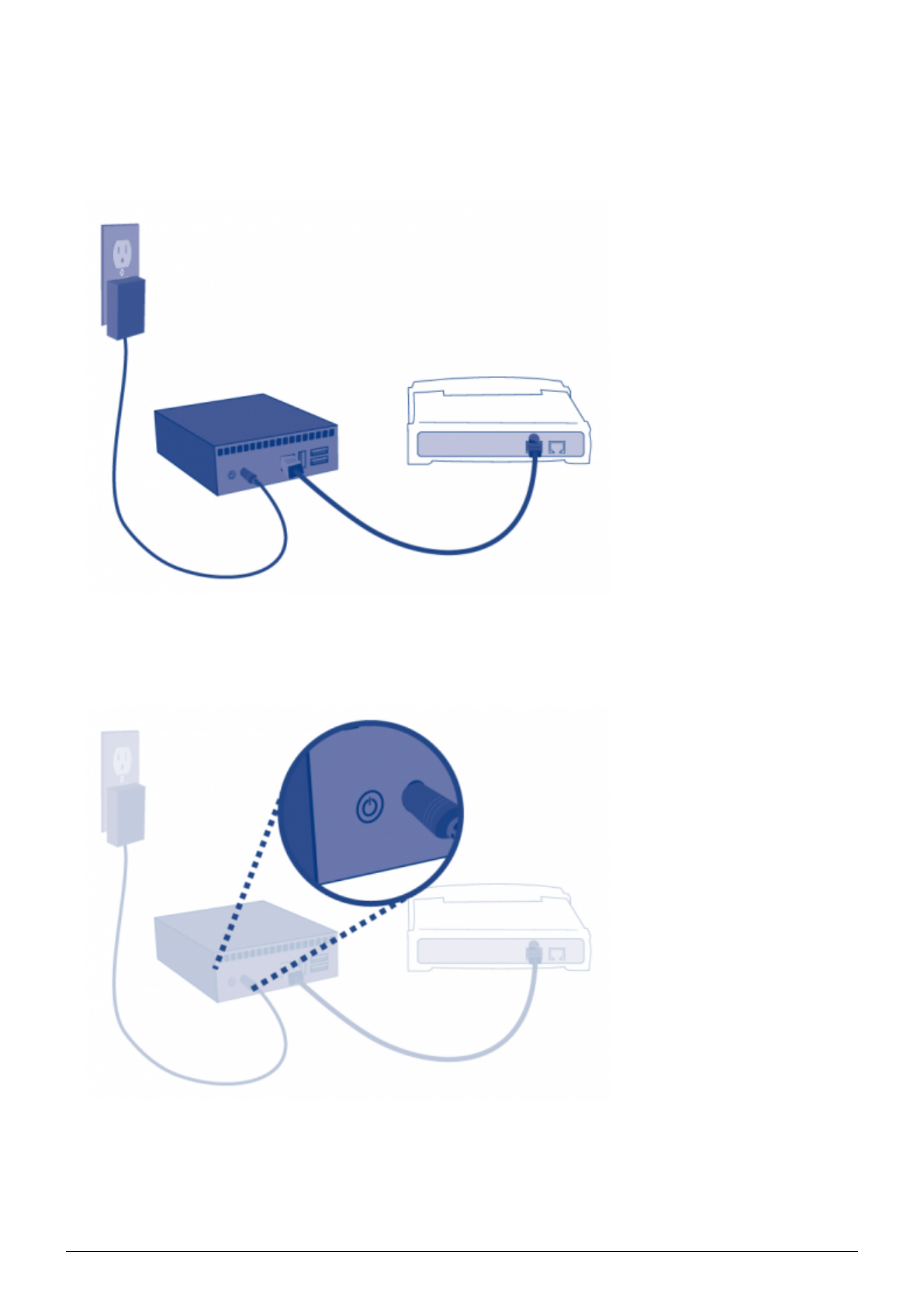
2 - CONNECT THE POWER SUPPLY
Connect the power supply to a wall outlet and to the product.1.
Push the power button until the front LED turns blue. Release the button and the LED will flash blue. Then the2.
product will boot, which may take up to two minutes. When the light becomes steady blue, the product is
ready to use.
LaPlug User Manual LaCie 7
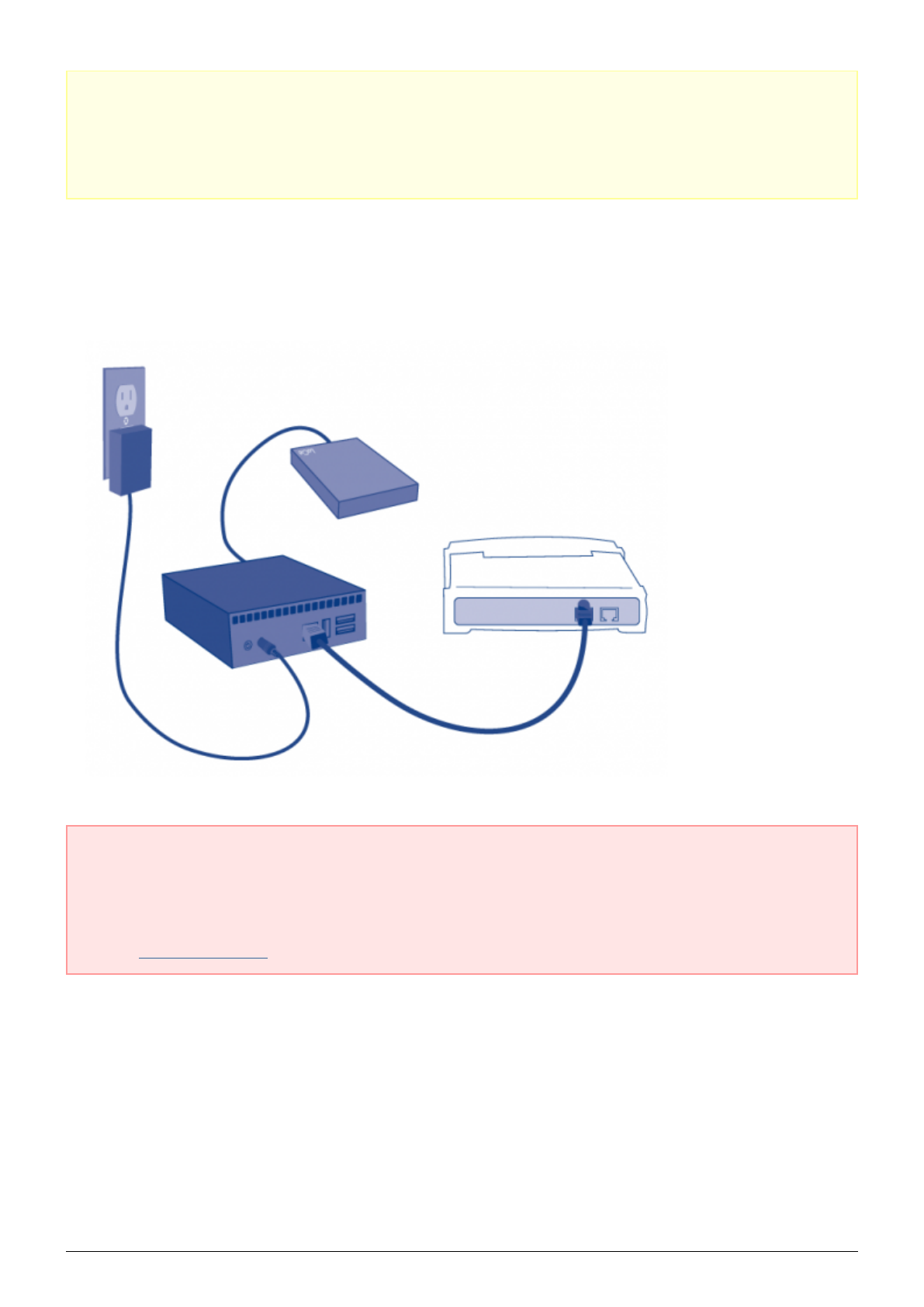
Caution: Only use the power supply supplied with your specific LaCie product. Do not use a power supply
from another LaCie device or another manufacturer. Using any other power cable or power supply may
cause damage to the device and void your warranty. Always remove the AC adapter before transporting
your LaCie drive. Failure to remove the adapter may result in damage to your drive and will void your
warranty.
3 - CONNECT USB DEVICES
Connect USB storage devices to the LaPlug's USB ports.1.
Important info: USB power failure: If you connect hard drive(s) to the LaPlug that experience a USB failure,
the LED will blink red, all connected USB devices will become inaccessible, and you will receive an error on
the Dashboard. Simply remove the last connected device and then follow the instructions that appear on the
Dashboard.
Refer to USB Power Failure for more information.
LaPlug User Manual LaCie 8

4 - INSTALL LACIE NETWORK ASSISTANT
Lacie Network Assistant detects all LaCie network-attached storage devices on your network and gives you easy
ways to connect to or configure them.
Note: If you've installed LaCie Network Assistant before purchasing this LaCie product, make sure that
you've downloaded and installed the latest version from the LaCie website.
Insert the CD-ROM into your computer's CD-ROM drive.1.
Windows users, the CD should appear in My Computer or Computer. Mac users, the CD should appear on2.
the Desktop. Double-click the CD icon, then double-click LaCie Network Assistant Setup.
Follow the Wizard to complete installation.3.
Note: After you finish installation, move on to Access USB Devices or Administer the LaPlug.
LaPlug User Manual LaCie 9
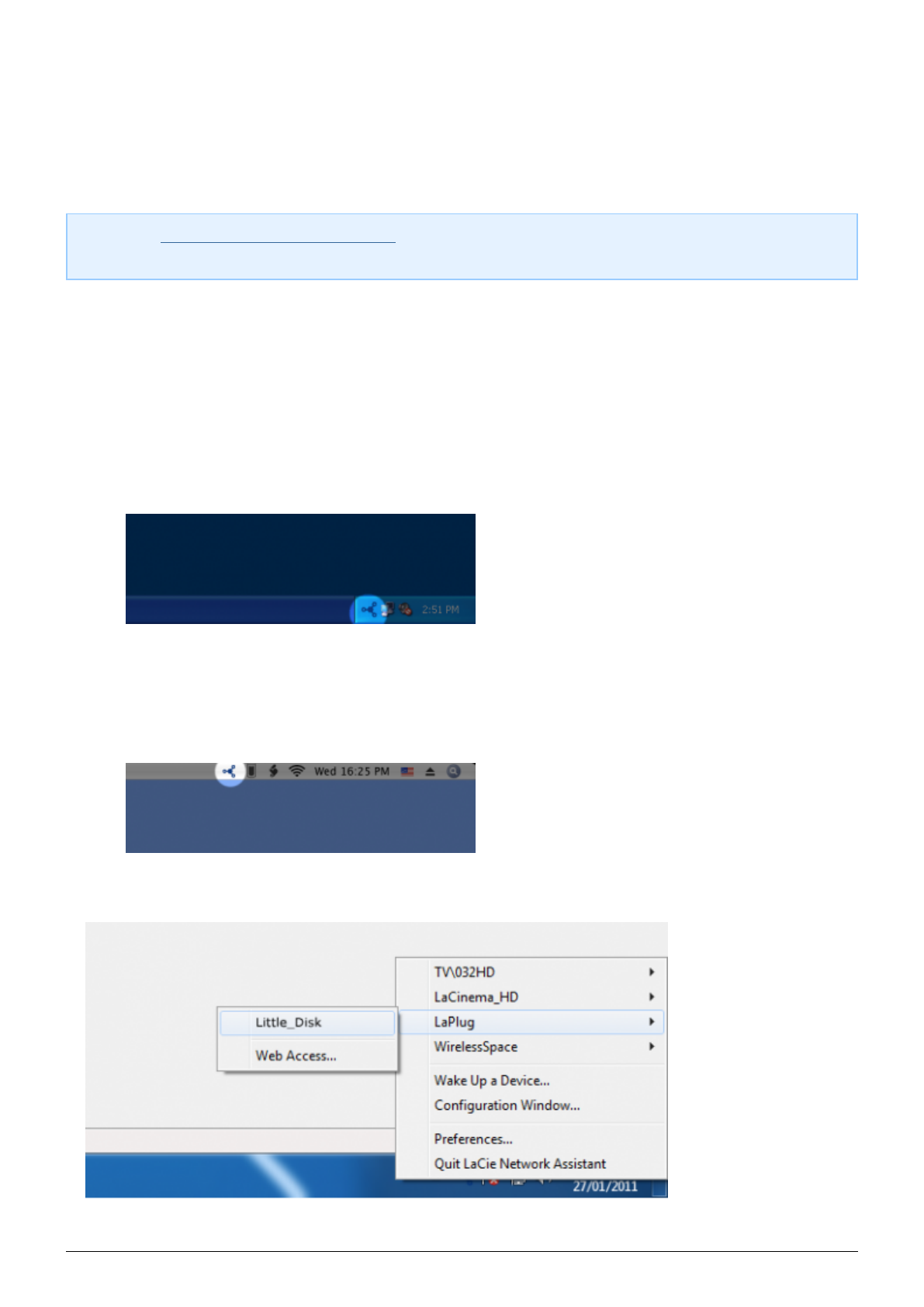
ACCESS USB DEVICES
You have several options for accessing the USB devices you have connected to your LaCie product.
Note: See Advanced Accessibility Features for related features such as accessing your device remotely,
creating shortcuts to your USB devices on the network, and multimedia streaming.
OPTION 1
Launch LaCie Network Assistant.1.
Windows Users:
■
Select LaCie Network Assistant in Start/Programs. A Network Assistant icon will appear in the system1.
tray and LaCie Network Assistant will automatically detect your LaCie product on the network.
Right-click on the icon in the system tray.2.
Mac Users:
■
Select LaCie Network Assistant in your Applications folder. A Network Assistant icon will appear in the1.
system tray and LaCie Network Assistant will automatically detect your LaCie product on the network.
Click on the icon in the menu bar.2.
Under the heading LaPlug, choose the device you want to access.2.
LaPlug User Manual LaCie 10
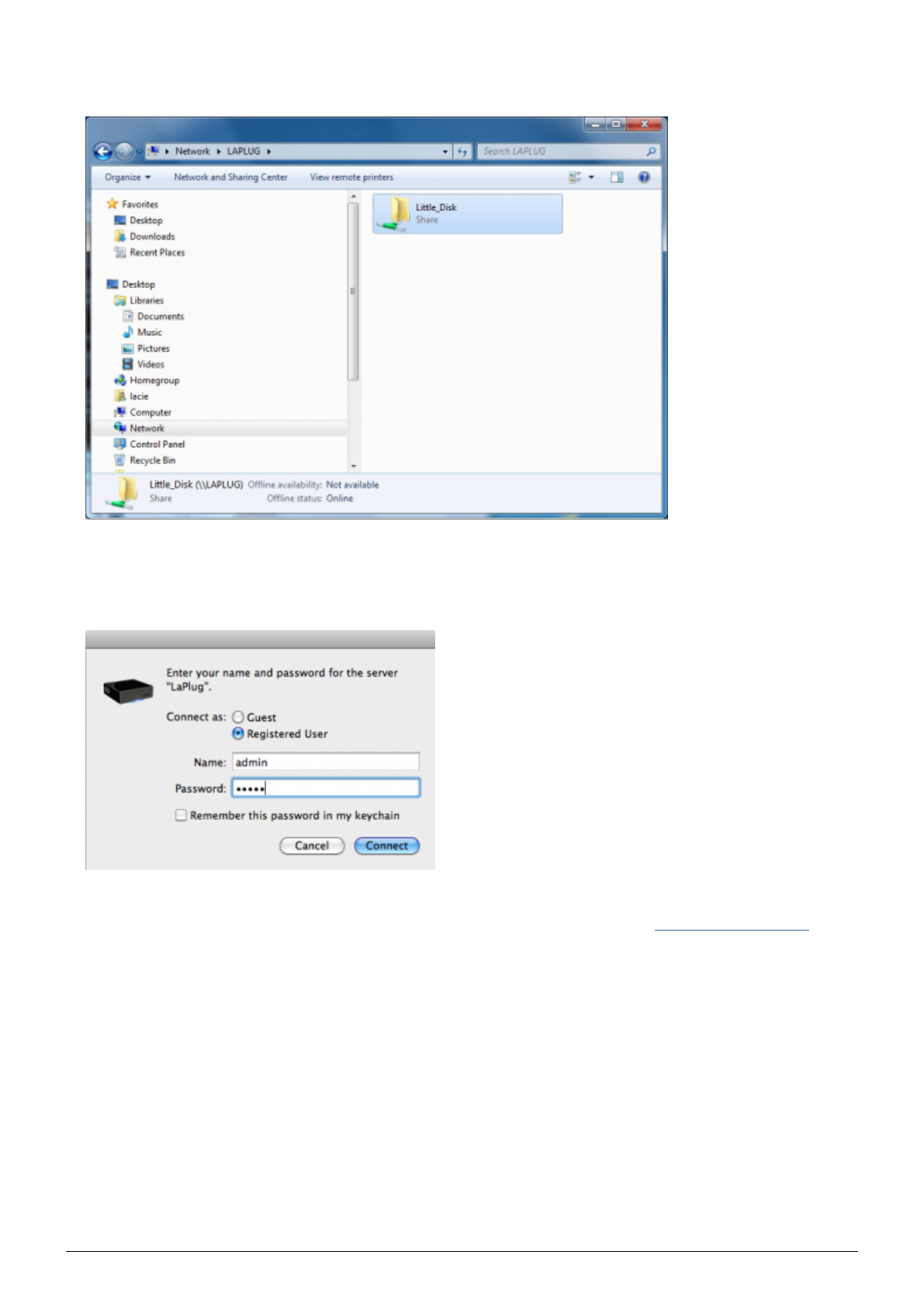
The USB device will open in a Finder window (Mac) or an Explorer window (Windows).3.
If you are prompted for a username/password, enter your username and password (by default):4.
Username = admin
Password = admin
If you have changed the username/password from the default admin/admin (see Administer the LaPlug),
enter your new credentials.
Transfer files normally between your computer and the USB device. Mac users: If the USB device does not5.
open in a Finder window, simply navigate in the Finder to Network > LaPlug > [disk name].
LaPlug User Manual LaCie 11
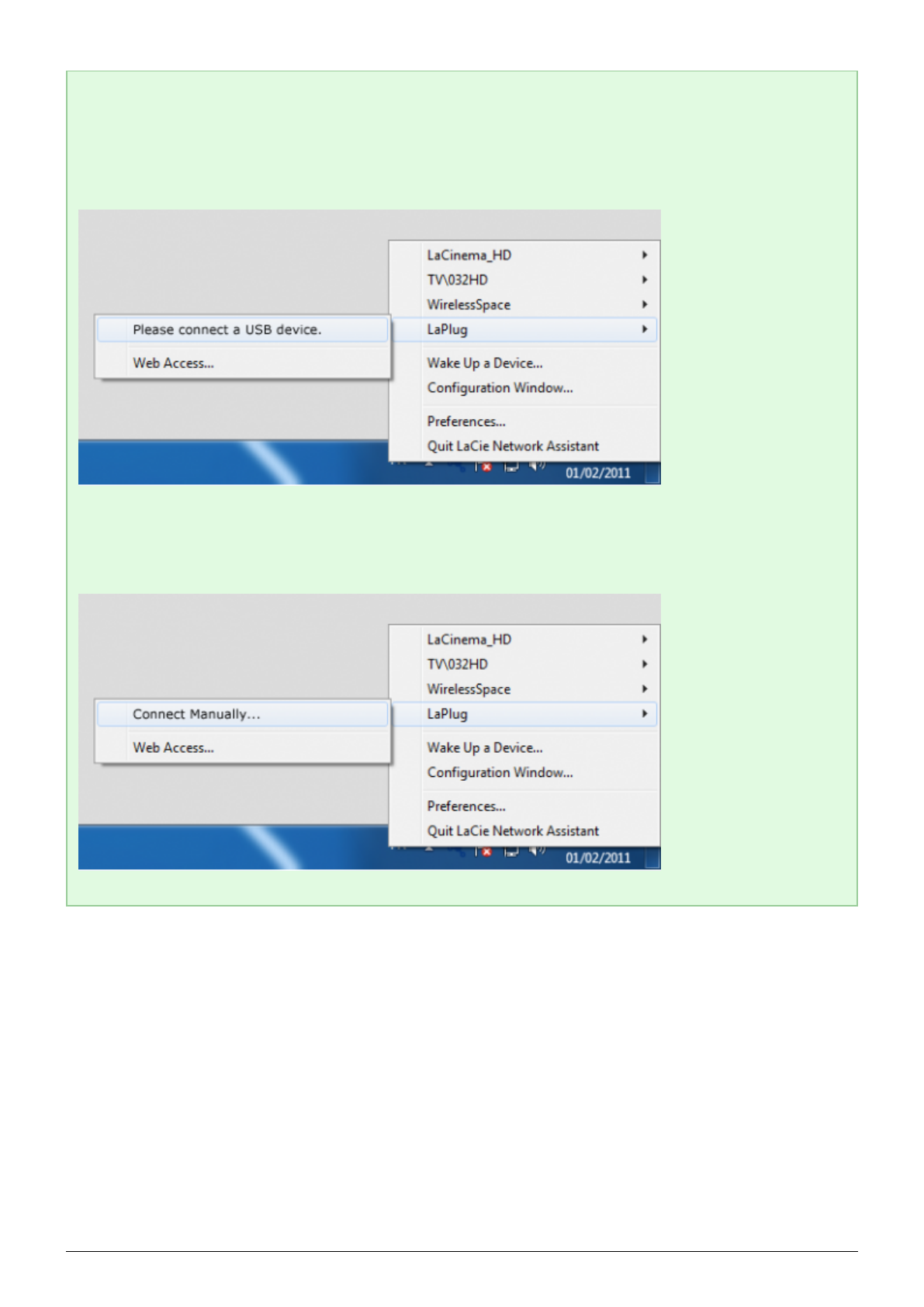
Technical note: Error notices in LaCie Network Assistant instead of USB device listing:
If no USB device is recognized, instead of the USB device name, you will see the text Please connect a
USB device. Make sure your device is connected and that it has been formatted. Refer to your device's user
manual for formatting procedure.
If you see the text Connect Manually instead of the USB device name, click Connect Manually. A Finder
window (Mac) or Explorer window (PC) will open, listing all the USB devices connected to your LaPlug.
LaPlug User Manual LaCie 12
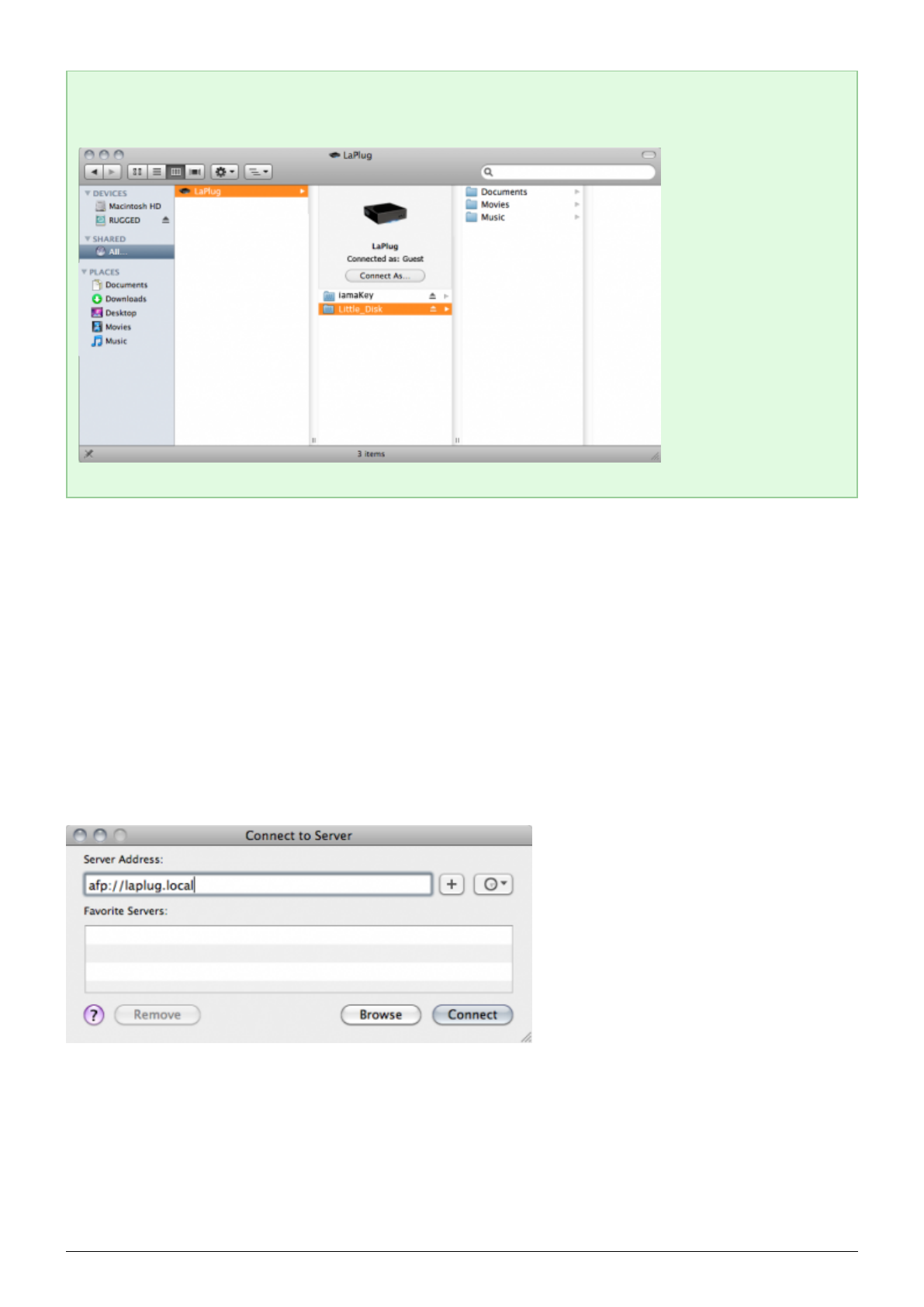
Technical note: Mac users: If the USB device does not open in a Finder window, simply navigate in the
Finder to Network > LaPlug > [disk name].
OPTION 2
Mac Users
In your Finder, navigate to Go > Connect to Server.1.
In the dialogue window that opens, type one of the following:2.
afp://laplug.local
smb://laplug.local
afp://[IP address]
smb://[IP address]
LaPlug User Manual LaCie 13
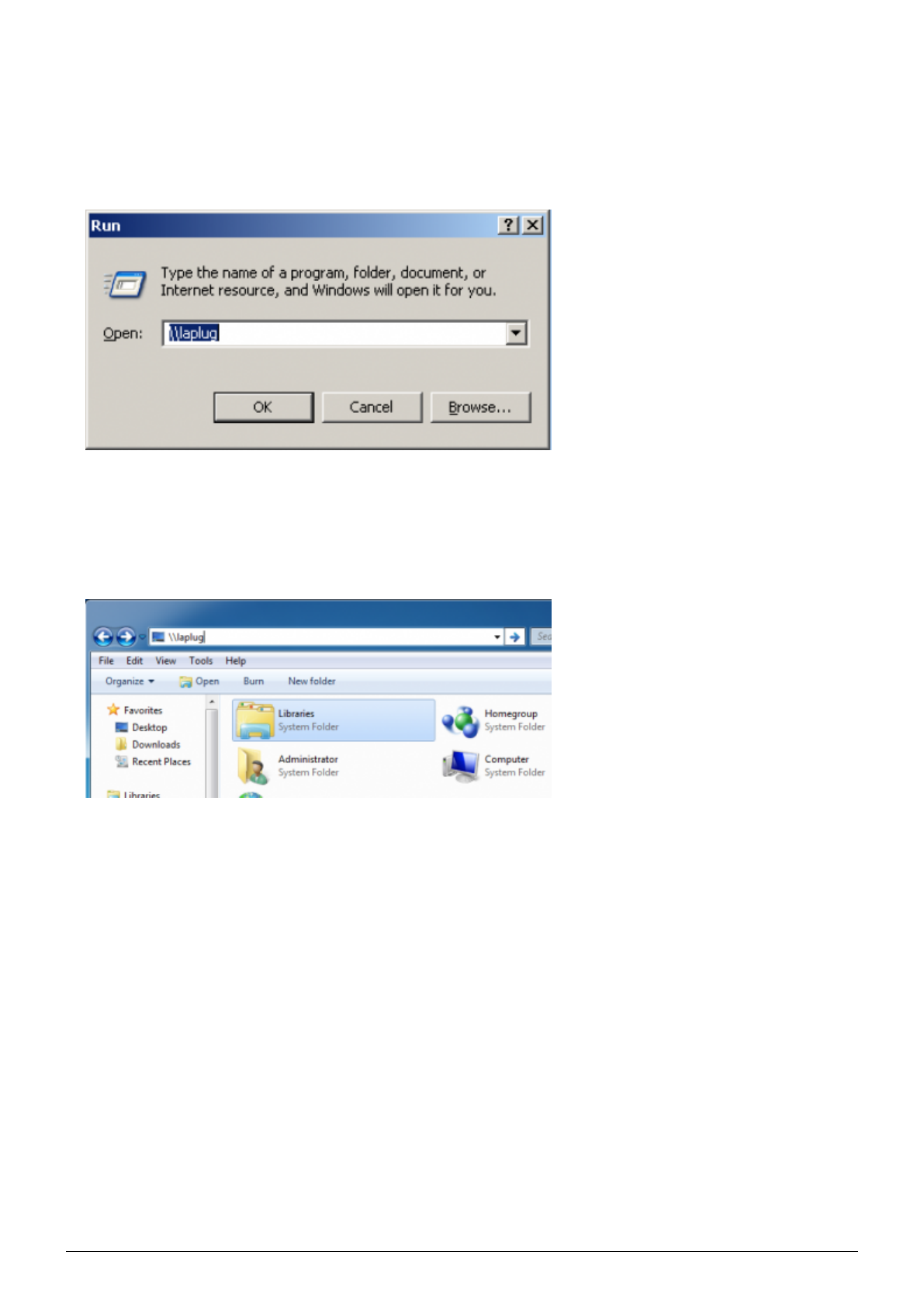
Windows XP Users
In an explorer window address field, type \\[Machine name] or \\[IP address]] and click Go. Alternatively,1.
from the Start menu, click Run, type \\[Machine name] or \\[IP address]] and click OK.
Windows 7 and Vista Users
In an explorer window address field, type \\[Machine name] or \\[IP address]] and hit enter.1.
LaPlug User Manual LaCie 14
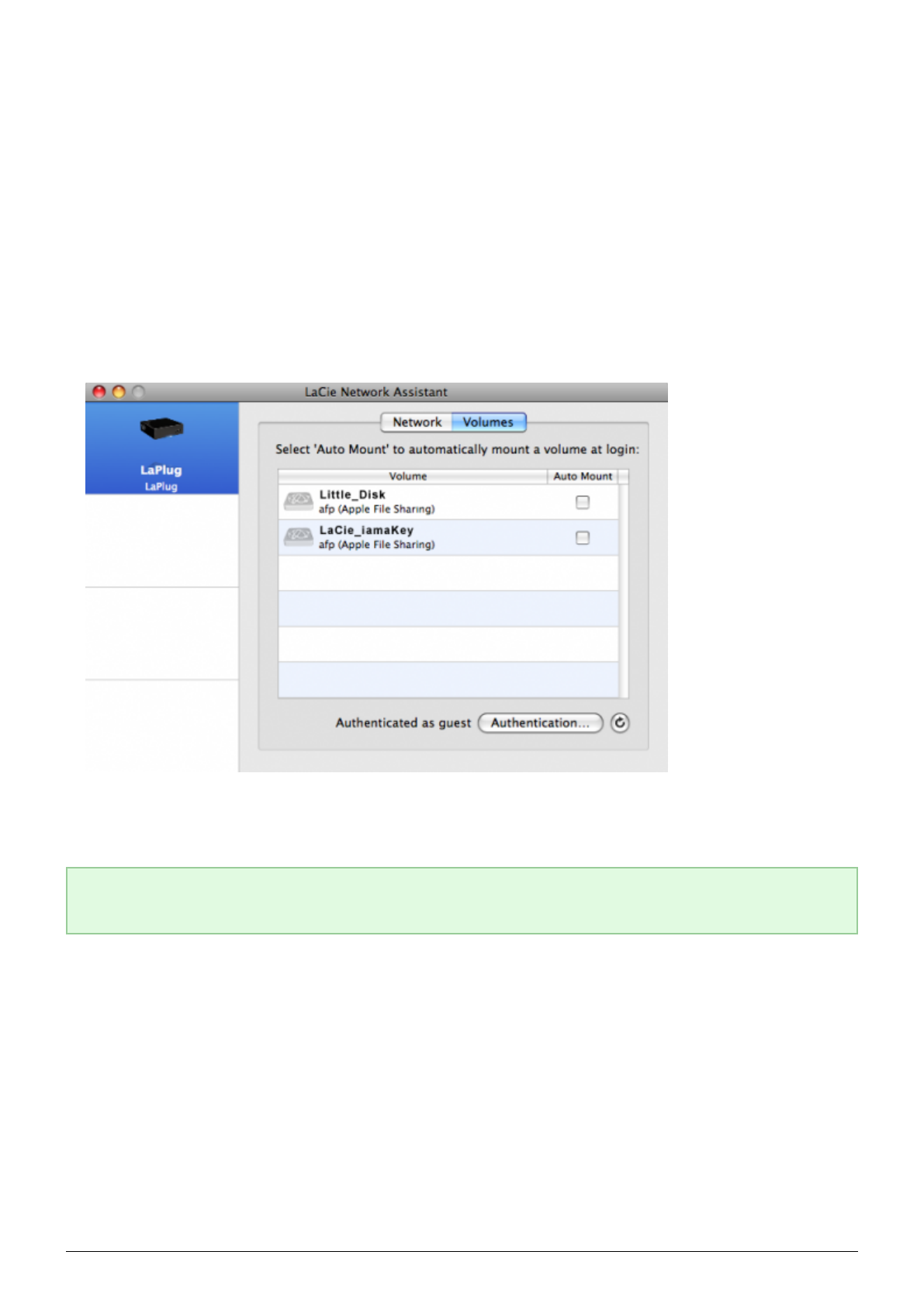
OPTION 3
Launch LaCie Network Assistant.1.
Windows Users: Select LaCie Network Assistant in Start/Programs. A Network Assistant icon will appear
■
in the system tray and LaCie Network Assistant will automatically detect your LaCie product on the network.
Mac Users: Select LaCie Network Assistant in your Applications folder. A Network Assistant icon will
■
appear in the system tray and LaCie Network Assistant will automatically detect your LaCie product on the
network.
Right-click the icon in the system tray (Windows) or click the icon in the menu bar (Mac) and select2.
Configuration Window.
Select the LaPlug from the list of devices in the left-hand column, then click the Volumes tab.3.
Double-click the USB device you wish to access. The USB device will open in a Finder window (Mac) or an4.
Explorer window (Windows). Transfer files normally from your computer to the USB device.
Technical note: Mac users: If the USB device does not open in a Finder window, simply navigate in the
Finder to Network > LaPlug > [disk name].
LaPlug User Manual LaCie 15
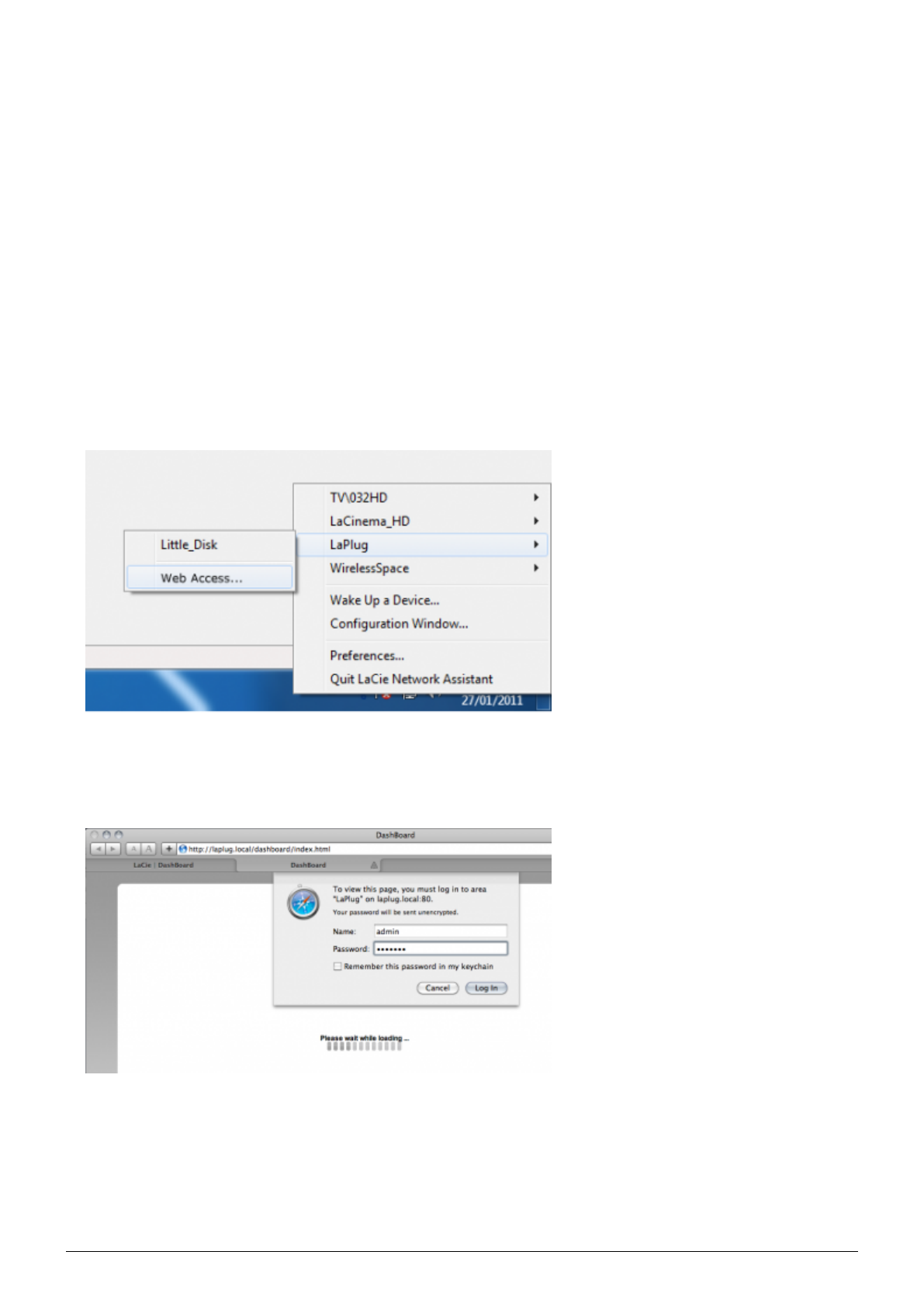
ADMINISTER THE LAPLUG
The LaCie LaPlug features an easy-to-use browser-based tool for configuring the drive called the Dashboard.
DASHBOARD - ACCESSING
There are two ways to access the Dashboard, using the LaCie Network Assistant and using a browser.
Use LaCie Network Assistant
Click on the LaCie Network Assistant icon in the system tray (Windows users) or menu bar (Mac users) and1.
select LaPlug > Web Access.
The LaCie LaPlug login page will open in a new browser window or tab. If your browser is not open, LaCie2.
Network Assistant will open it for you.
In the login prompt, enter your username and password (case sensitive; default is admin/admin).3.
Click Log in.4.
LaPlug User Manual LaCie 16
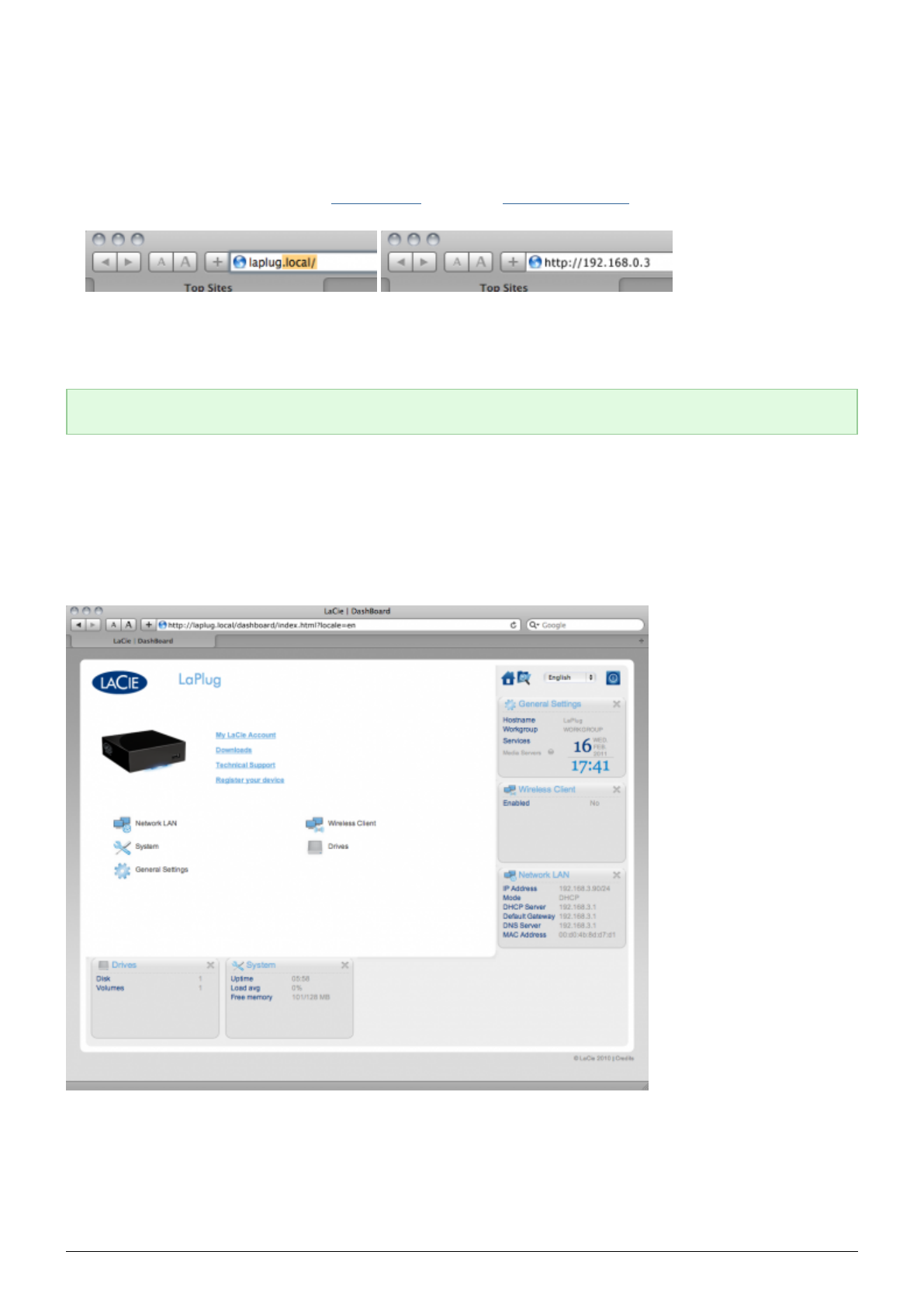
Use a Browser
Open your Internet browser (Firefox, Internet Explorer, Safari, etc.) and type your LaCie LaPlug's IP address or1.
machine name (by default, LaPlug) in the browser's URL (web address) field.
For example: http://[IP-address] or http://LaPlug (Windows) http://LaPlug.local (Mac)
In the login prompt, enter your username and password (case sensitive; default is admin/admin).2.
Click Log in.3.
Technical note: Find your device's IP address in the LaCie Network Assistant Configuration Window.
DASHBOARD - HOME
The welcome page contains links to helpful documents from the LaCie website and a list of the different pages
that make up the Dashboard.
LaPlug User Manual LaCie 17
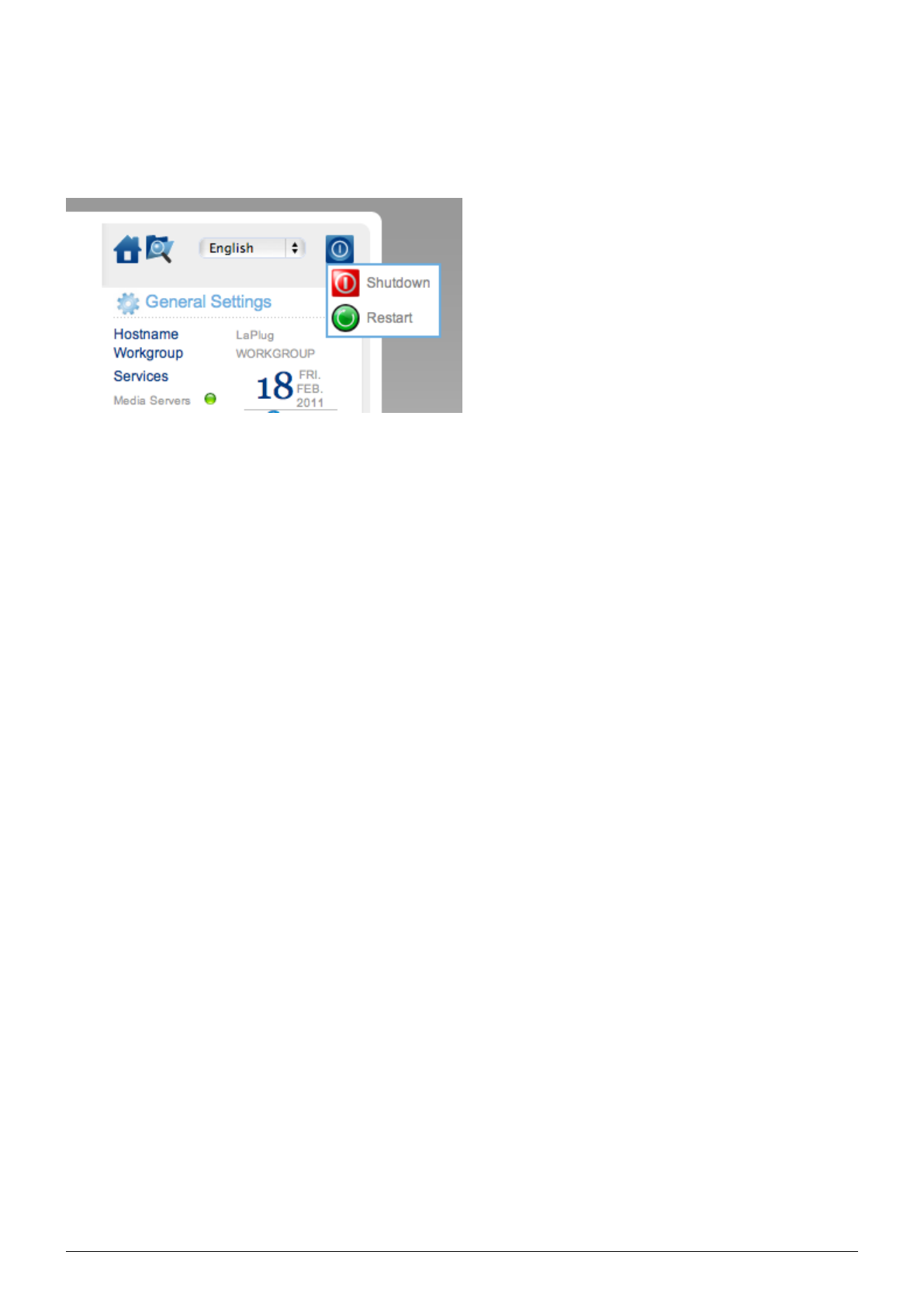
Restart or Shutdown
To restart or shut down the drive, click this button, then choose between Restart and Shutdown.
DASHBOARD - NAVIGATION
The Dashboard is made up of a central area surrounded by widgets, or small boxes that represent the different
pages that make up the Dashboard. The widget displays a summary of the information contained in the page.
For full information, navigate to the page itself.
To navigate to a page, click the widget below its title; or, drag and drop a widget to the center of the
■
window.
To minimize a widget, click the X next to its title.
■
To expand a minimized widget, drag its icon over an expanded widget or to an open widget space.
■
To rearrange widgets, drag the minimized widget icon or the expanded widget's heading onto the place of
■
another widget.
LaPlug User Manual LaCie 18
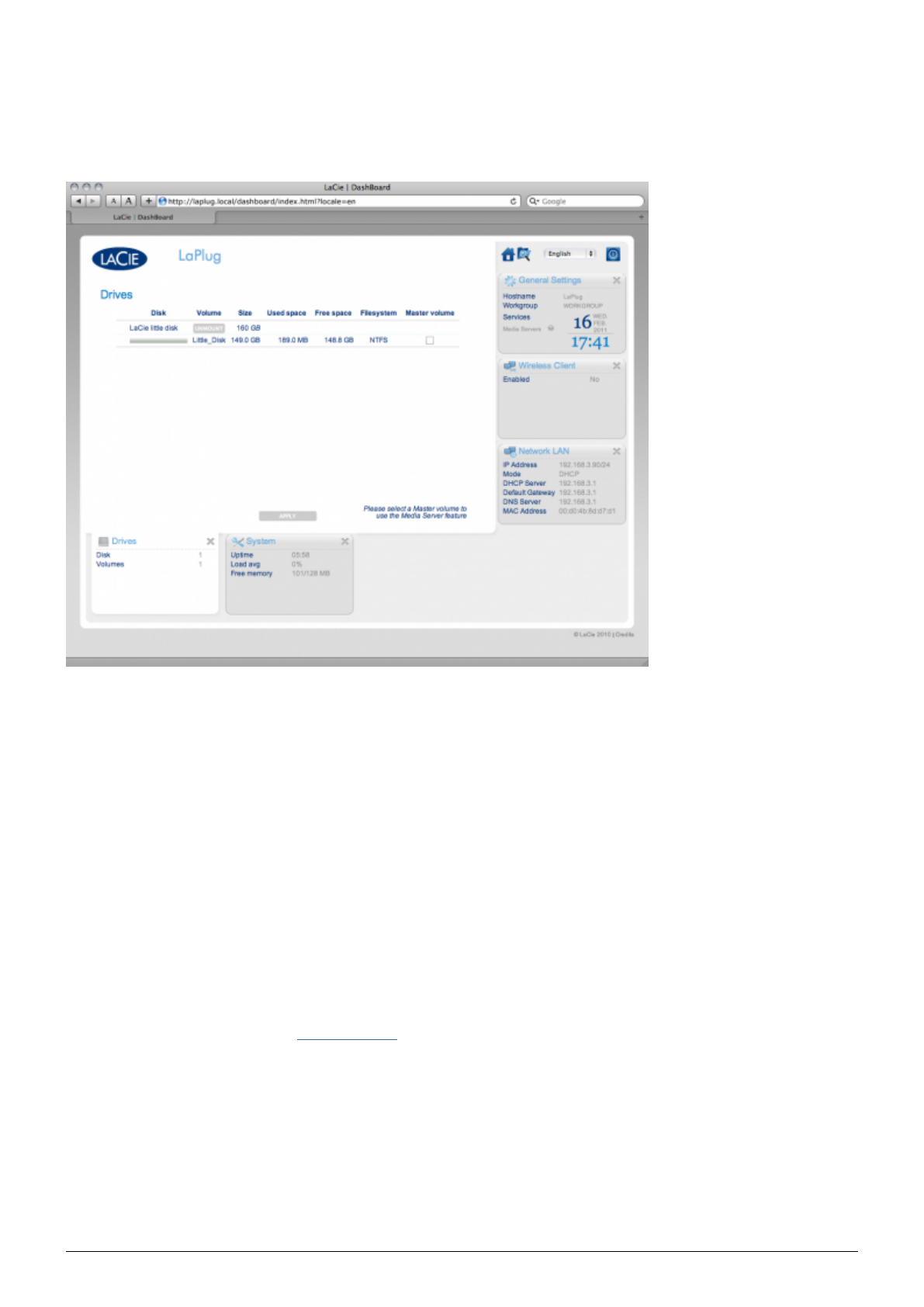
DASHBOARD - DRIVES
This page will list all the USB devices connected to your LaPlug.
Every USB device will take up at least two rows in the table; the first row describes the disk, and its volumes (or
partitions) each take up an additional row(s). So a disk with a single partition will take up two rows, and a disk
with two partitions will take up three rows, etc.
Disk: This column will normally list the drive's manufacturer (or a graphical indication of free space for
■
partitions).
Volume: This column lists a button to unmount the disk or the name of the drive's partition.
■
Unmount: To prevent file system corruption, it's important to unmount a drive by clicking this button
■
before unplugging it.
Size: Indicates the drive's total capacity.
■
Used Space: Indicates how much of the disk's capacity is in use.
■
Free Space: Indicates how much of the disk's capacity is available.
■
File System: Indicates the drive's file system.
■
Master Volume: One of the attached drives must be designated as the master volume in order for the Media
■
Server feature to function. See Media Servers.
LaPlug User Manual LaCie 19
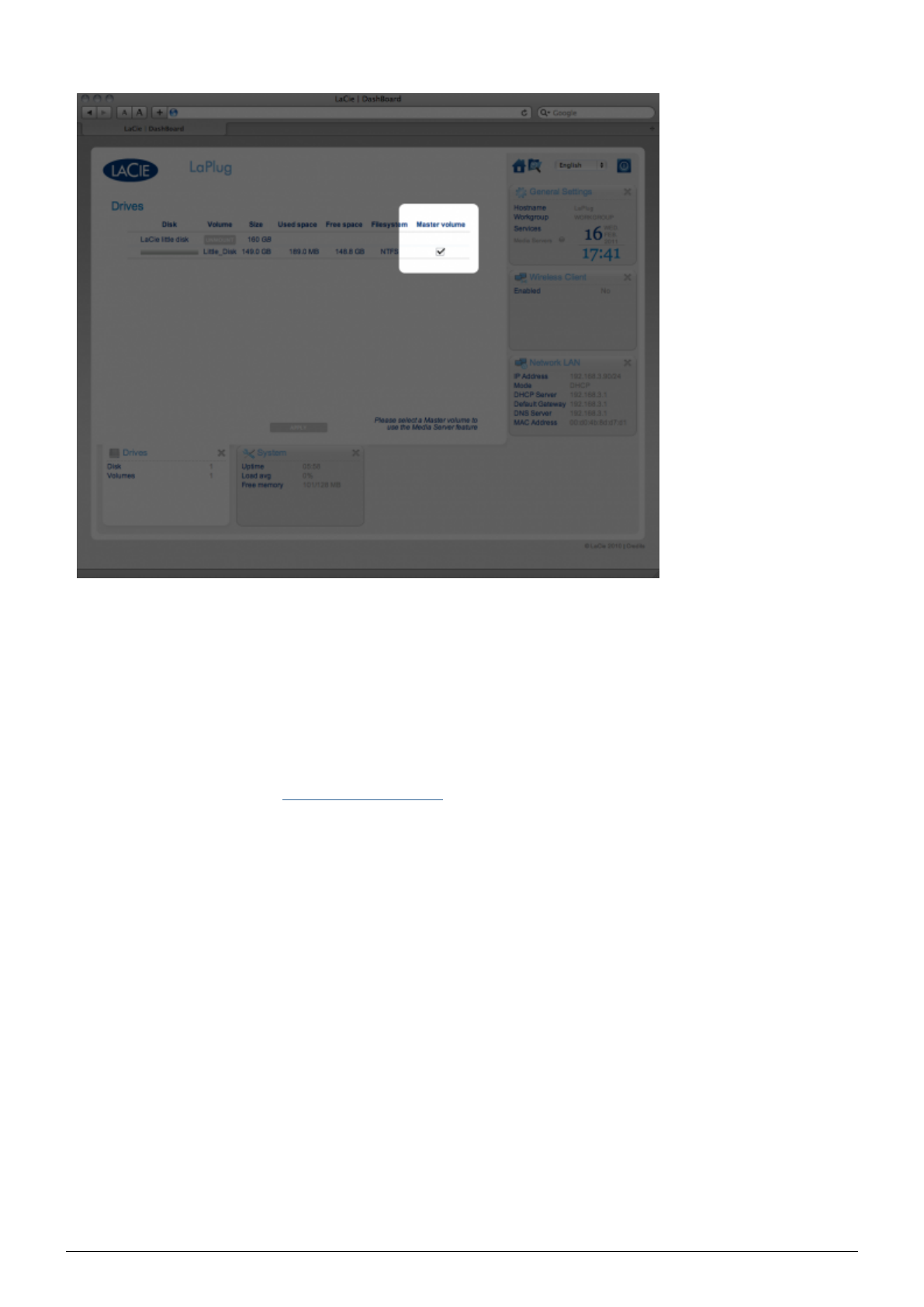
USB Power Failure
If you connect hard drive(s) to the LaPlug that experience a USB failure, the LED will blink red, all connected
USB devices will become inaccessible, and you will receive an error on the Dashboard. USB failures could be the
result of a defective USB device or USB cable, or insufficient power being supplied to the USB device.
To resolve the issue, unplug the last-connected USB device. Next:
Launch the Dashboard (see Dashboard - Accessing).1.
You will see this screen:2.
LaPlug User Manual LaCie 20
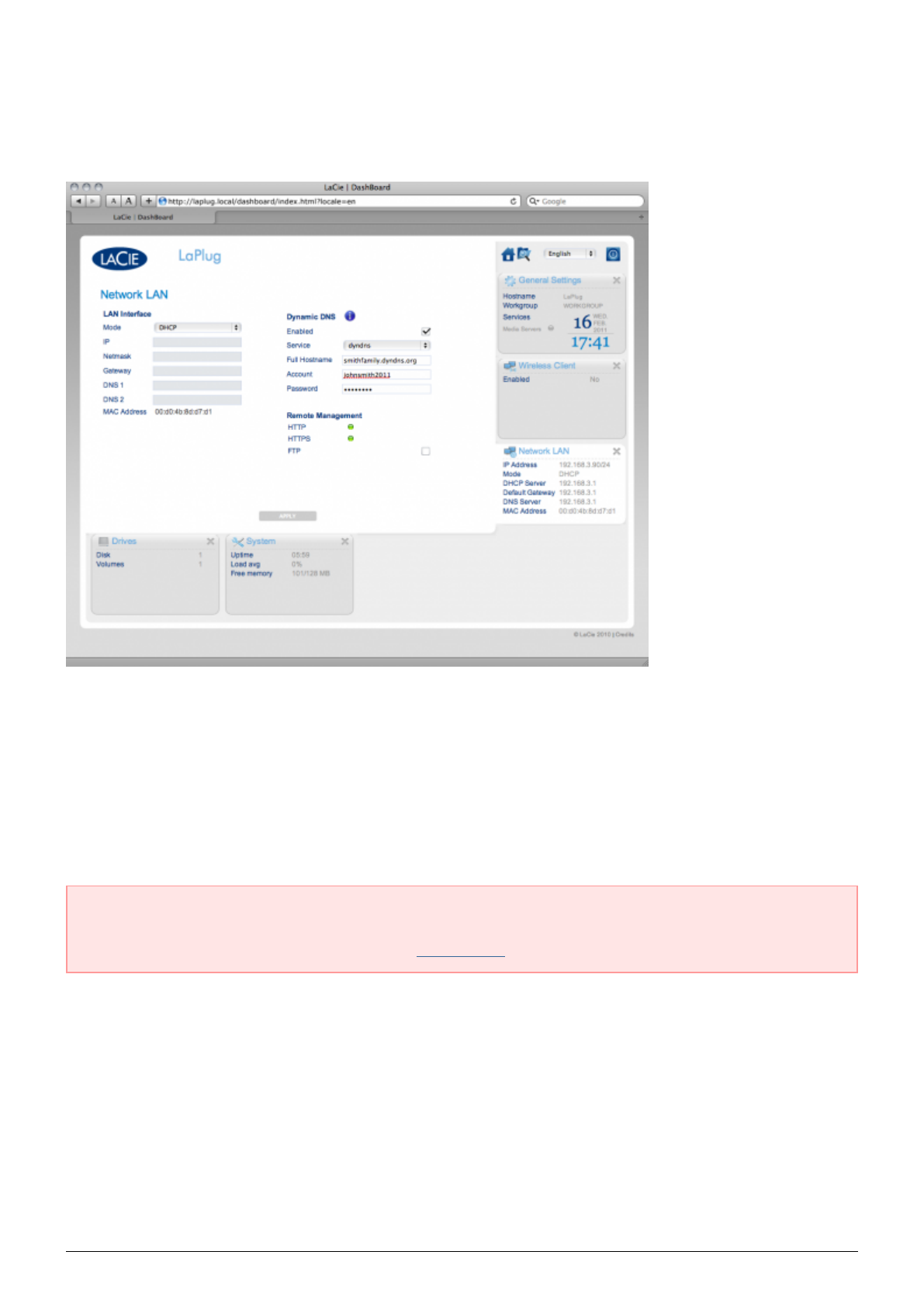
DASHBOARD - NETWORK LAN
This page allows you to modify your LaPlug's network LAN settings.
LAN Interface
Mode: Choose whether the LaPlug should be automatically assigned an IP address and other values by your
DHCP-managed network (DHCP), or if values should be assigned manually (Static). If you choose static, you
will be able to type in the fields below.
Important info: If your LaPlug doesn't shut down correctly, as in the case of a power failure, when it
reboots it will default to DHCP mode, and you will have to reset your static IP values. To avoid this, shut
down the LaPlug using the power button (see Introduction) or from the Dashboard.
Dynamic DNS (Remote Access)
Click the Enabled box, then select a service and fill out the fields below. This function allows you to use a third
party Dynamic DNS service to create an easy-to-remember URL for accessing your LaPlug remotely. This service
is free and no subscription is required. For details and to watch a screencast which will help you to set up
remote access, click the i button next to the headline Dynamic DNS.
LaPlug User Manual LaCie 22
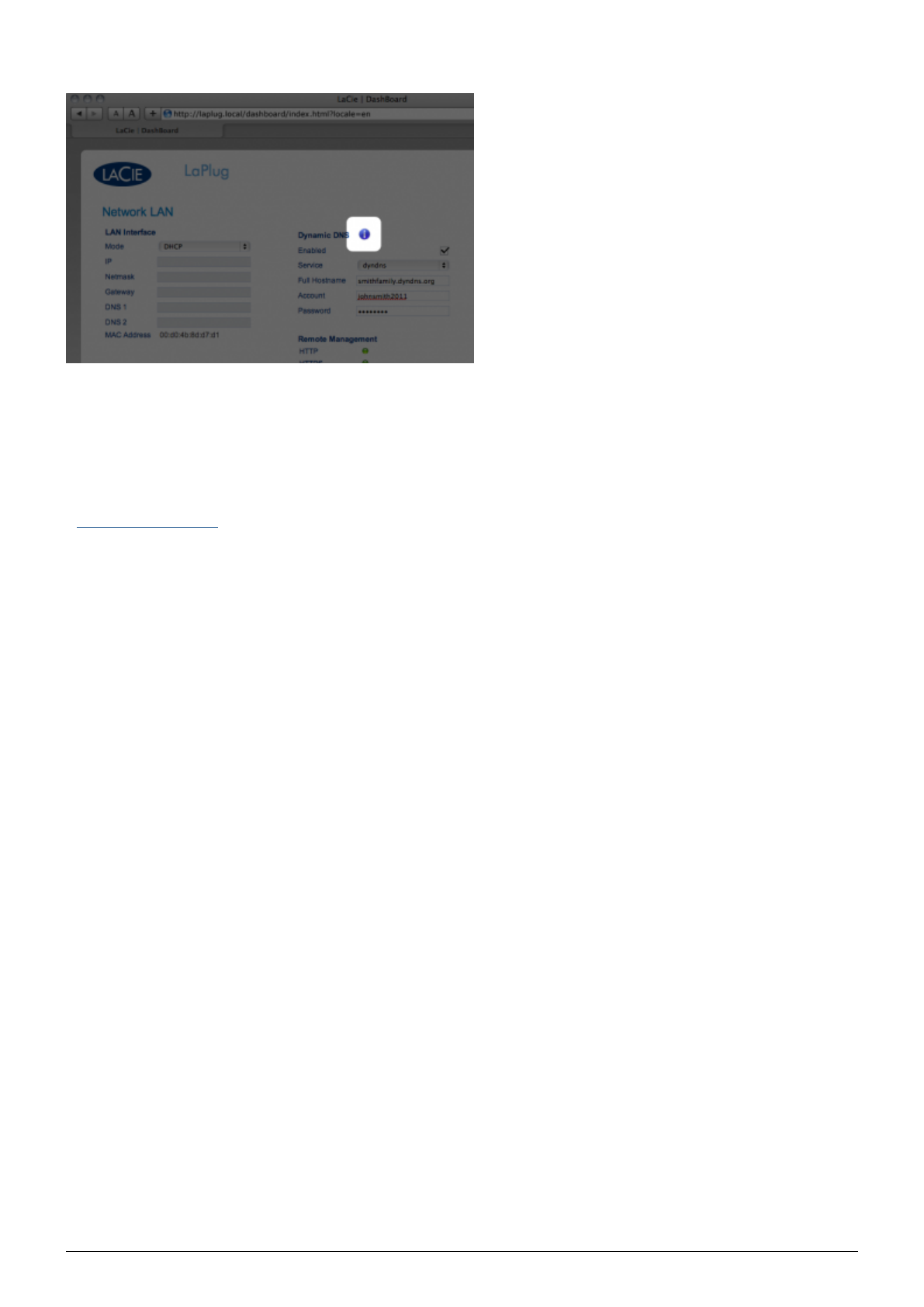
Remote Management
HTTP/HTTPS: These lights will be green if the UPnP IGD server acknowledges port forwarding is successful.
■
FTP: Toggle this feature on/off to allow your LaPlug to be accessible via File Transfer Protocol (FTP). See
■
Access USB Devices for details.
After modifying any of the above settings, click the Apply button.
LaPlug User Manual LaCie 23
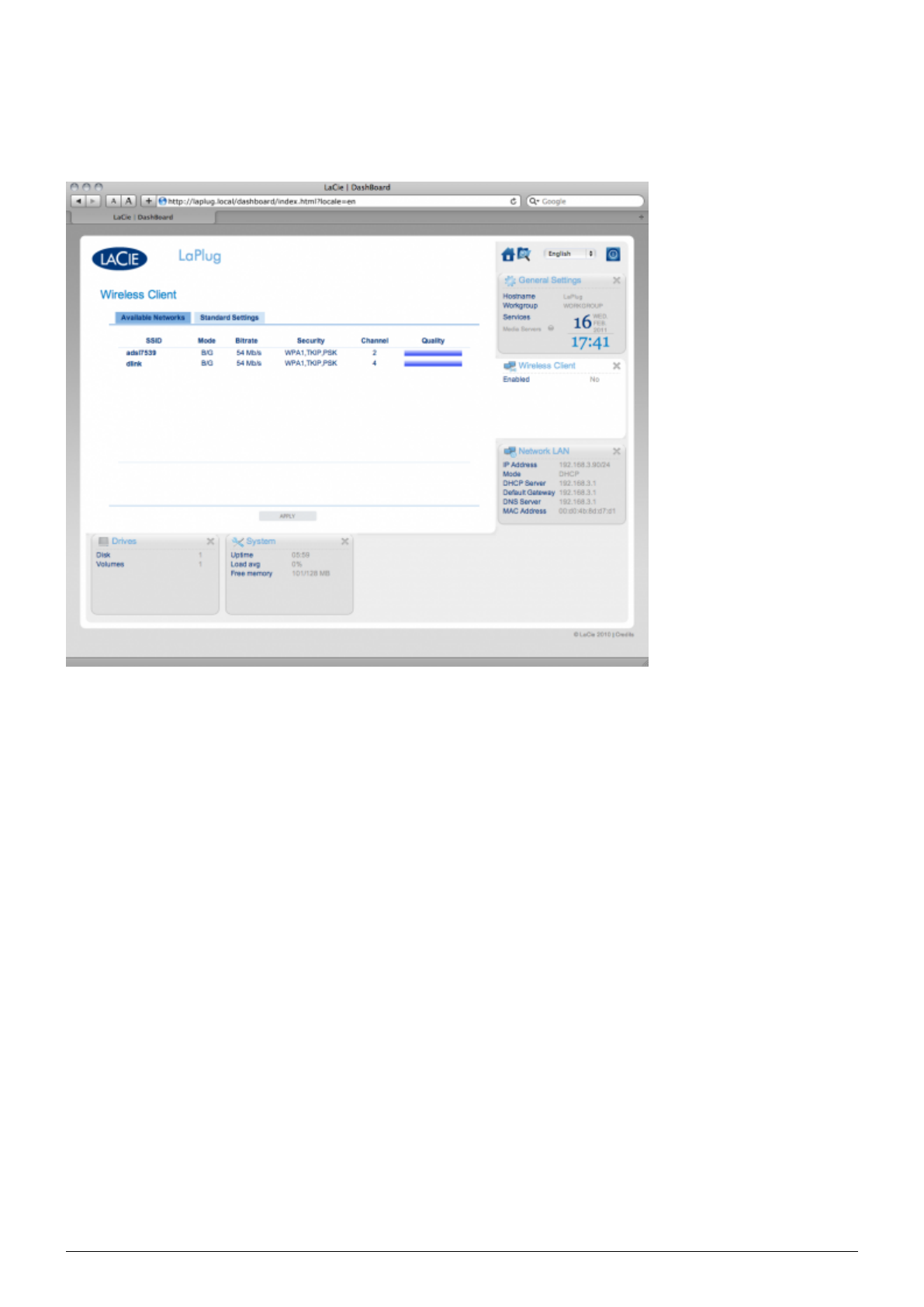
DASHBOARD - WIRELESS CLIENT
This page will allow you to connect your LaPlug to your wireless network. Note that Ethernet is the default
connection, so you must initially connect the LaPlug to your network via the Ethernet cable. After successfully
connecting to a wireless network, simply disconnect the Ethernet cable.
Available Networks Tab
All detected wireless networks will be listed as well as their technical specifications. To connect to a wireless
network:
Click an SSID to select the network. The Standard Settings tab will be displayed with connection details for1.
the selected network.
LaPlug User Manual LaCie 24
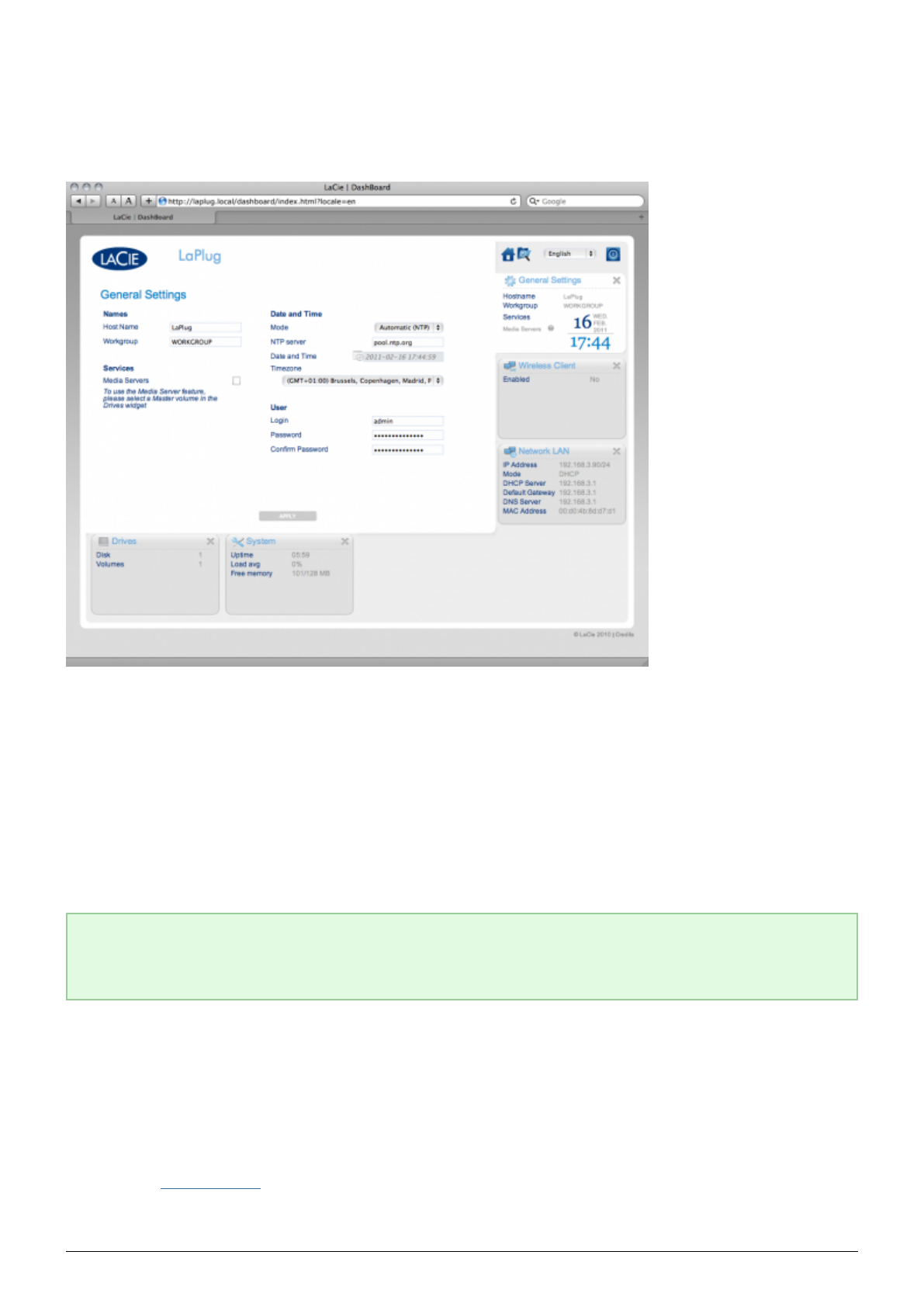
DASHBOARD - GENERAL SETTINGS
This page allows you to modify some of your LaPlug's general parameters.
Names
Host Name: Modify the machine name. The machine name identifies your LaPlug in LaCie Network Assistant
■
and on the local network. The machine name is limited to 15 characters. Please use alphanumeric characters
without spaces or symbols.
Workgroup: Type a Windows workgroup name to connect your LaPlug to a Windows workgroup.
■
Technical note: Mac users connected to a network with Windows computers can also access USB devices
this way by selecting in the Finder Network > [Workgroup] > LaPlug where “Workgroup” is the name of
the Windows workgroup.
Services
Media Servers: This feature allows your LaPlug to act as a UPnP multimedia server. Files stored on USB
■
devices connected to the LaPlug will be available to play on UPnP-enabled players (such as cell phones,
computers, and game consoles). A master volume must be selected in Dashboard > Drives to use this
media server feature. For information on using your LaPlug to stream files to your UPnP devices including
iTunes, see Media Servers. Note that if you've just added new content to the LaPlug, it could take a few
minutes before they are available to UPnP/DLNA-certified players/adapters.
LaPlug User Manual LaCie 26
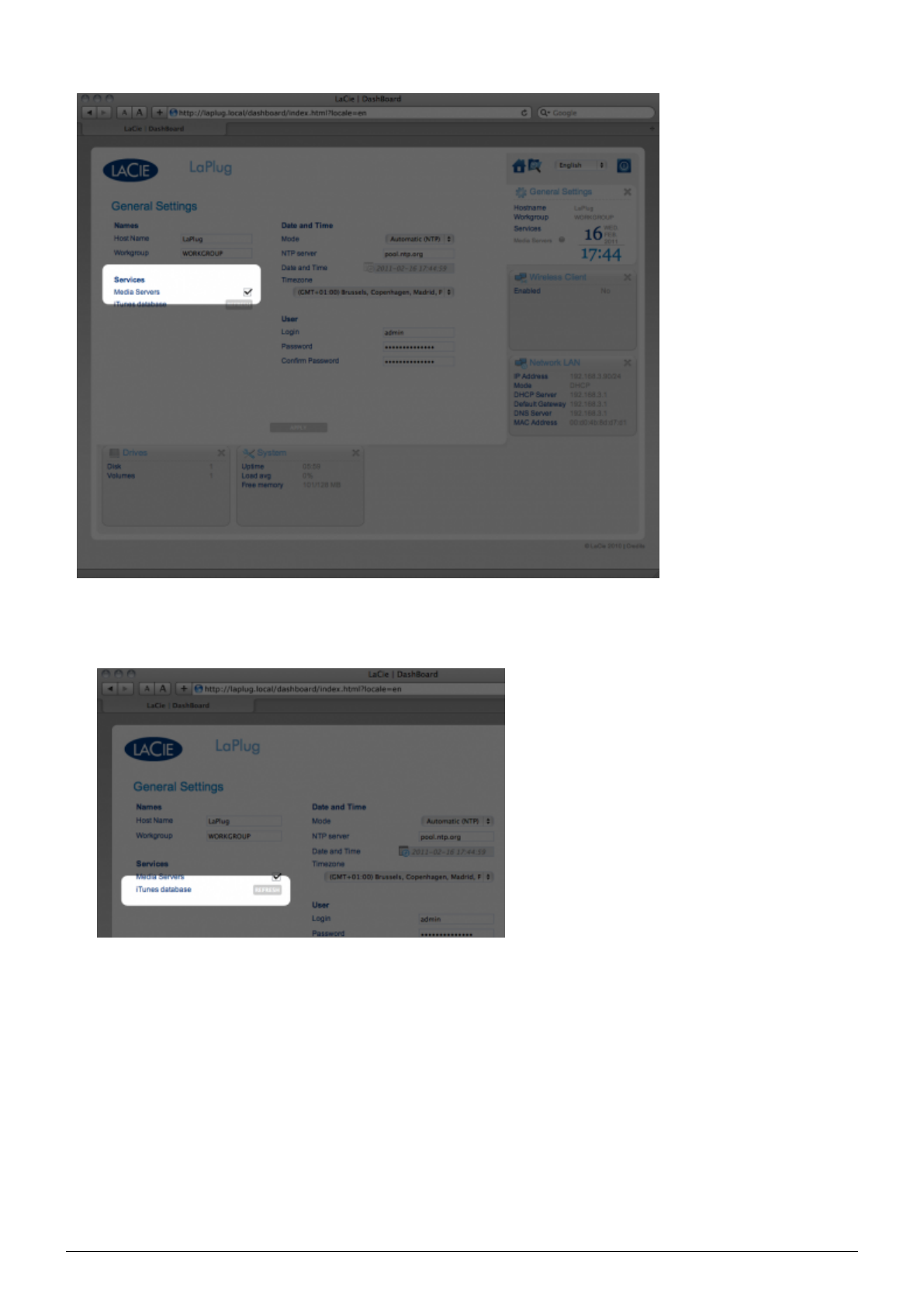
iTunes database: If you've recently added audio files to the a USB device connected to the LaPlug, click
■
the Refresh button. The LaPlug will index the files and make them available to iTunes.
Date and Time
Mode: Your LaPlug can either sync date/time with your PC or with a Network Time Protocol server. Make your
■
selection, then click the calendar button to sync.
LaPlug User Manual LaCie 27
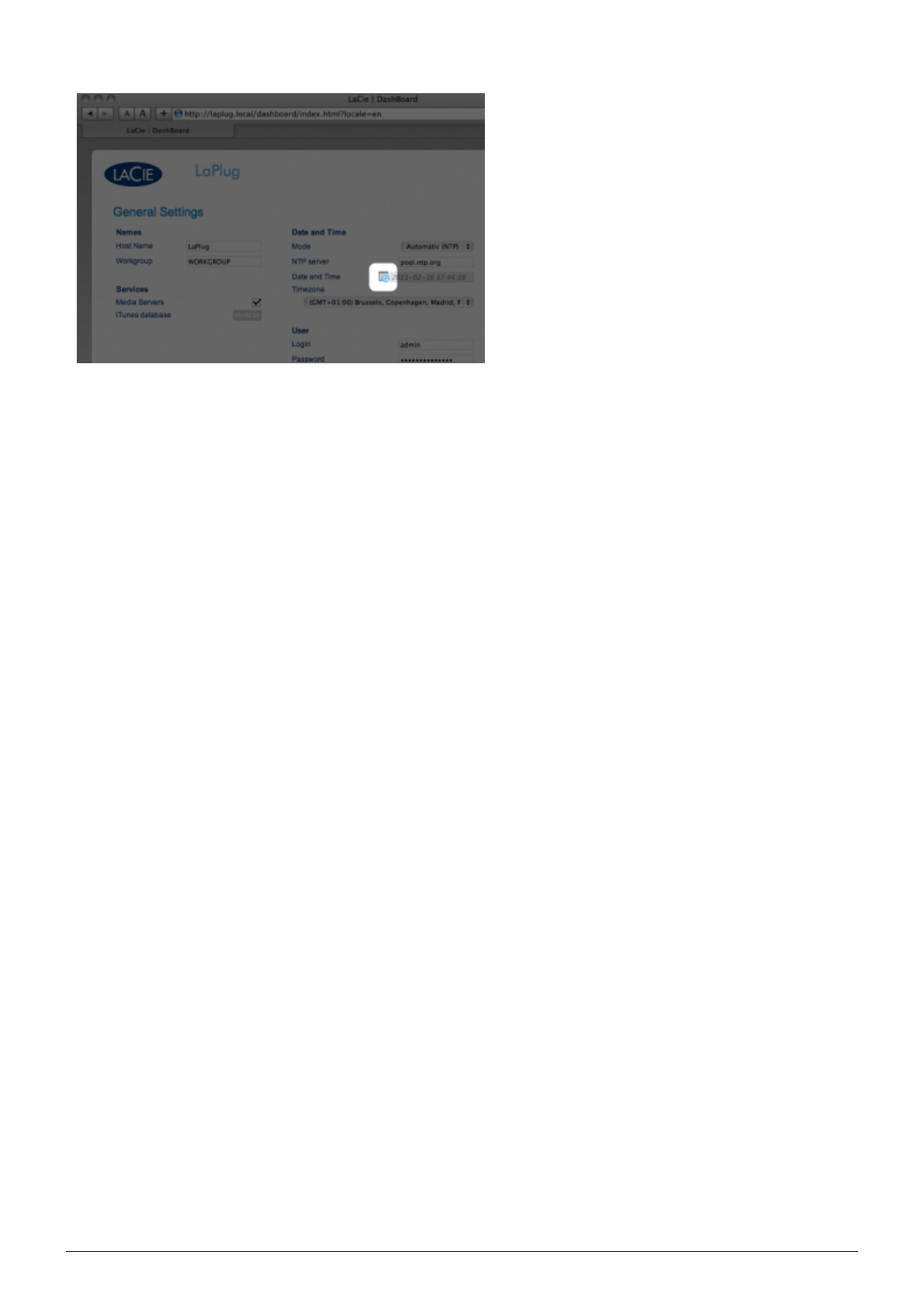
Timezone: Choose your timezone.
■
User
Login: Change the username used to access the Dashboard and USB devices (using the Finder for Mac users
■
or Explorer Window for Windows users).
Password: Change the password used to access the Dashboard and USB devices.
■
Confirm Password: Retype the password.
■
After you modify any of the above parameters, click the Apply button.
LaPlug User Manual LaCie 28
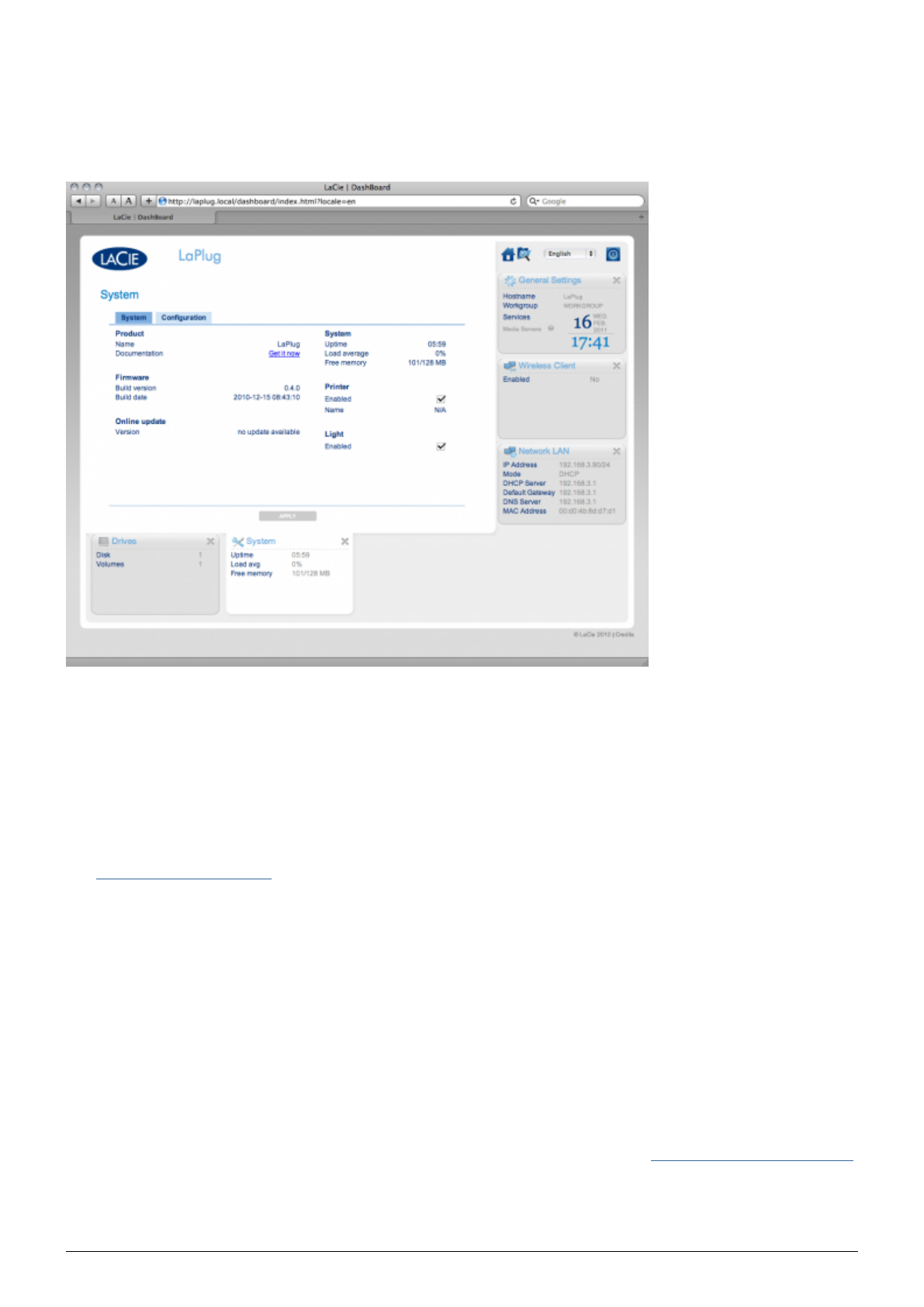
DASHBOARD - SYSTEM
This page collects technical information about your LaCie device and controls several features.
System Tab
Online Update
See Update Product Software.
Printer
You can connect a compatible USB printer to one of the LaPlug's USB ports to make that printer available
throughout your network. Note that your printer must be compatible with the CUPS (Common Unix
Printing System) standard. Check your printer manufacturer's website to verify.
Follow these steps:
Make sure the LaPlug is connected and visible on your network.1.
Make sure that your printer's drivers have been installed on the computer from which you want to print.2.
Connect the printer's USB cable to the LaPlug and power on the printer.3.
Windows users: To simplify the process of discovering your printer on the network, install Apple's Bonjour4.
Print Services for Windows software. For more information and to download, see support.apple.com/kb/DL999.
Once you install the software, it will help you discover and configure your networked printer.
Print normally.5.
LaPlug User Manual LaCie 29
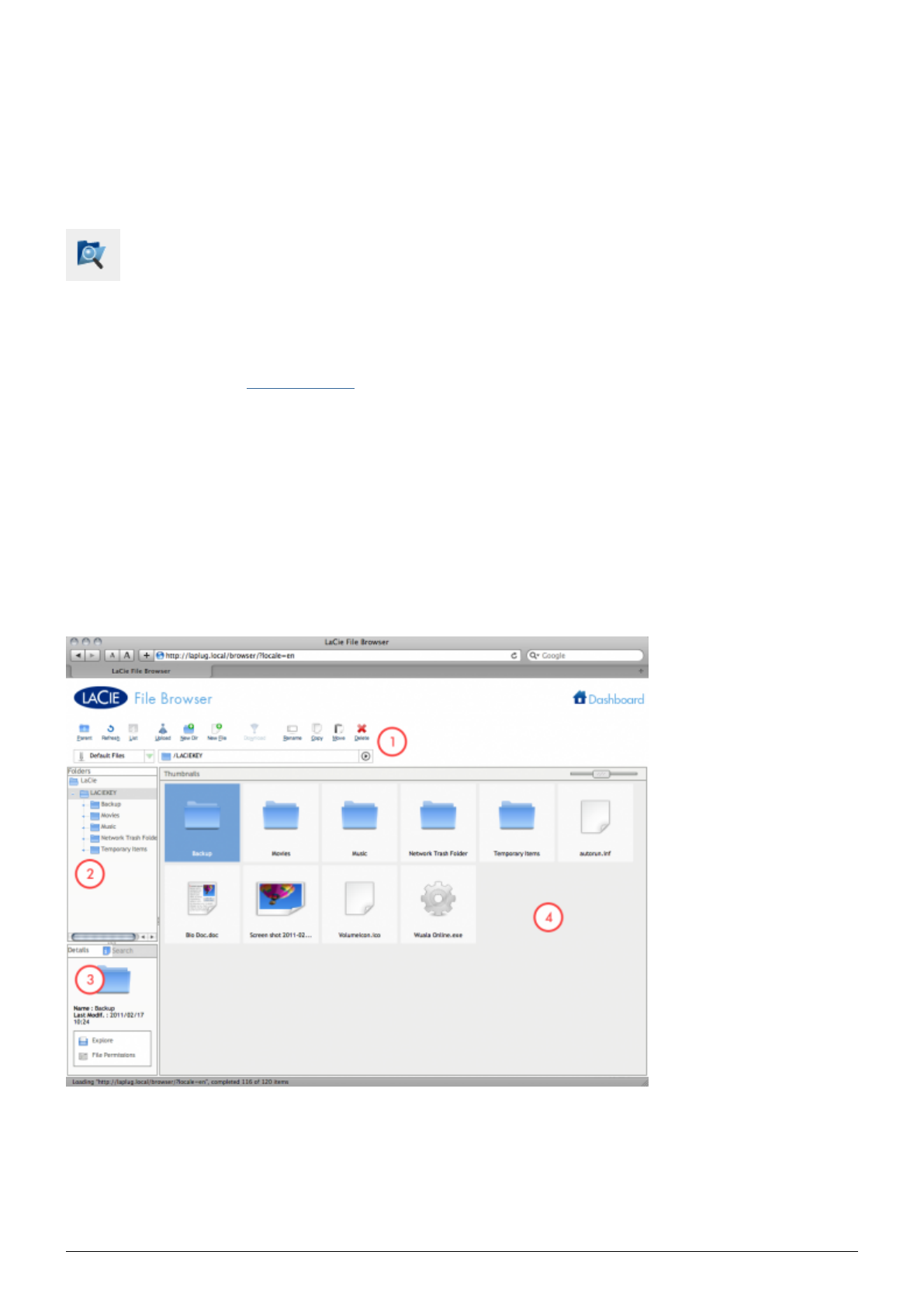
DASHBOARD - FILE BROWSER
The Dashboard features an interactive file browser that allows you to manage and transfer files via HTTP.
Access the File Browser by clicking its icon in the upper right-hand corner of the Dashboard.
The File Browser allows you to transfer, copy, and delete files, as well as view photos in thumbnails and even
stream multimedia content such as mp3 or view photos. It is thus a convenient way to interact with files stored
on your external hard drives through the network, whether the connection be through the local network or
through the internet (see Remote Access). Also, since the File Browser permits faster file transfer than
drag-and-drop (SMB), it is most effective for transferring large files.
The File Browser is composed of five parts:
The toolbar allows you to perform a range of functions, such as changing the way files are displayed and1.
uploading files to streaming files and creating folders.
Folders shows the folder structure on the selected share.2.
Details displays information on a selected file, such as name, thumbnail (image files), file type, dimensions3.
(photos), or duration (videos), while Search allows you to search for files based on file name.
This section displays the files contained in a selected folder. To view the files as thumbnails, click Thumbs in4.
the Tool bar.
You can view photos full-size as well as stream certain types of music and text files. Select the file, then:
Photo: Click the View button in the toolbar.
■
LaPlug User Manual LaCie 31

ADVANCED ACCESSIBILITY FEATURES
This chapter will describe your LaCie product's advanced accessibility features such as remote access, creating
shortcuts to your USB devices on the network, and multimedia streaming.
REMOTE ACCESS
You can access files stored on the USB devices connected to your LaPlug when you are away from home. You
can download or upload files from any computer connected to the Internet, or manage your LaPlug.
LaCie has created a screencast that demonstrates this process. Either click here to follow the link, or
alternatively, from the Dashboard > Network page, click the “i” next to the Remote Access heading to access
the screencast.
For further information on network settings, see Dashboard - Network LAN.
Once connected, it is easy to access your files using the web browser-based File Browser. You can upload,
download, and stream many types of multimedia files such as mp3. For more information on the File Browser,
see Dashboard - File Browser.
CREATING SHORTCUTS TO USB DEVICES
Once you successfully set up your LaPlug and connect a USB device(s), you can create shortcuts so you can
quickly access stored files. You can do this by using your operating system or LaCie Network Assistant.
Create Shortcut Using LaCie Network Assistant
LaCie Network Assistant (LNA) can be configured to automatically mount USB devices on your computer, which
allows you quick access to the files they store. To create this shortcut to USB devices using LNA, follow the steps
below:
From the LNA menu, click Configuration Window.1.
Select LaPlug from the left-hand column.2.
Click the Volumes tab.3.
Next to the device(s) you wish to map, click the check box under the column Auto Mount. If you see the4.
message “can't list volumes,” it may be because you are using an outdated version of LNA. Download the
most recent version from the LaCie website.
LaPlug User Manual LaCie 33
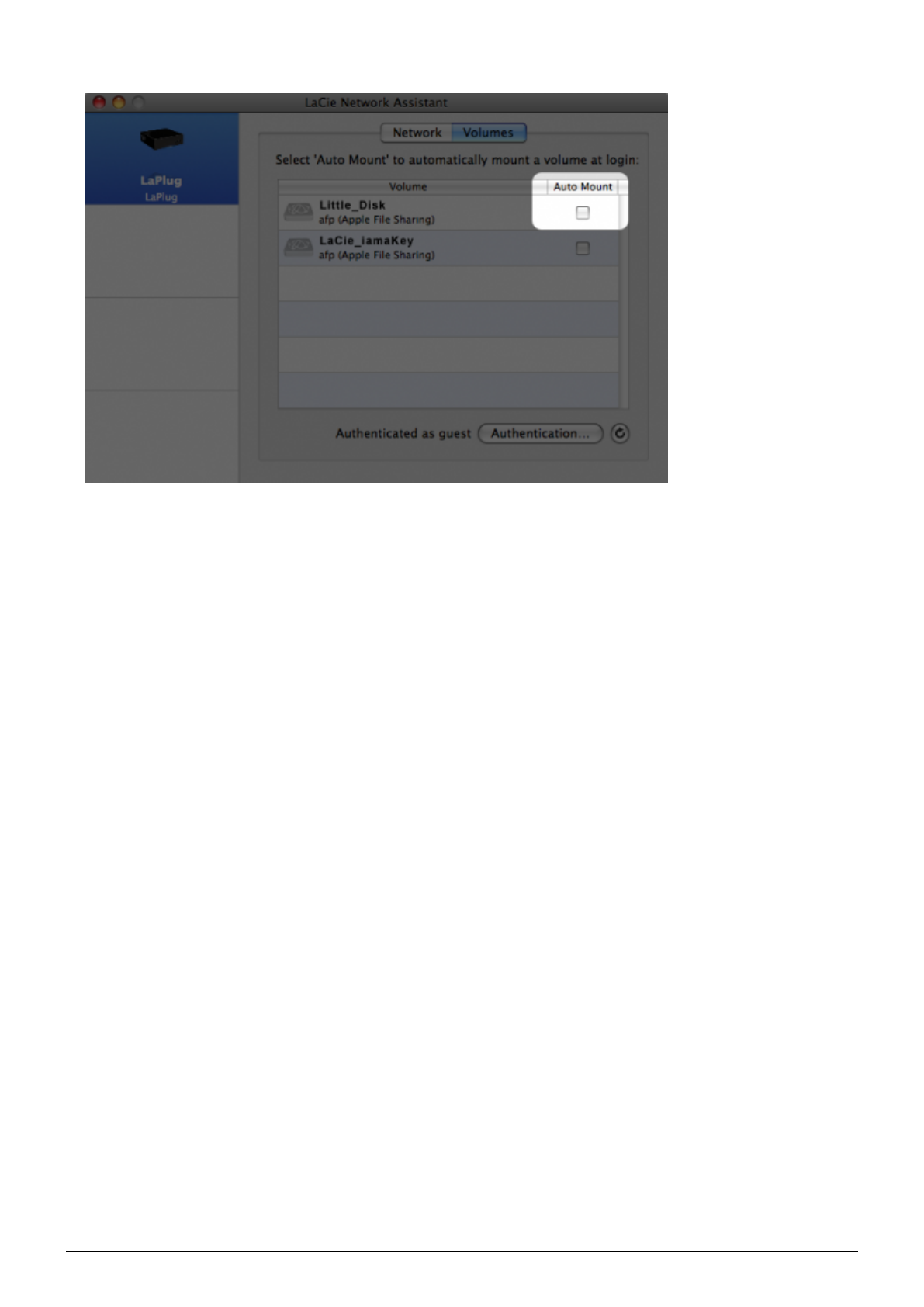
PC users: The USB device will mount in My Computer/Computer automatically when the computer detects5.
it on the network.
Mac users: The USB device volume icon will appear on your desktop and in your Finder automatically when
the computer detects it on the network.
Create Shortcut Using Operating System
If you would like a shortcut to accessing USB devices, follow this procedure.
Windows XP, Vista, and Windows 7 Users
From an Explorer window in Windows XP, select Tools> Map Network Drive. For Windows Vista and1.
Windows 7, open an Explorer window, navigate to Computer, and click Map Network Drive.
LaPlug User Manual LaCie 34
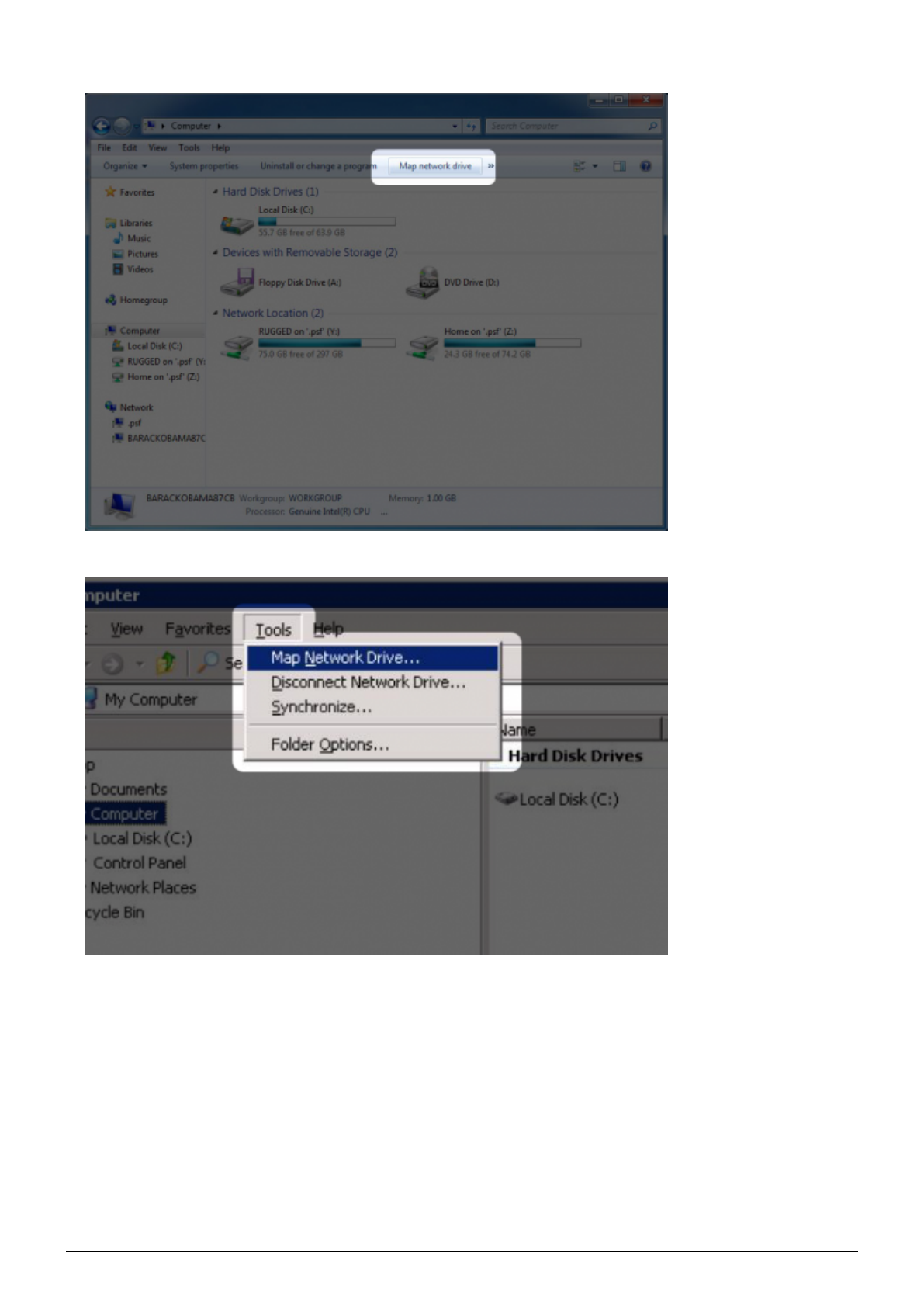
Browse to and select the device you wish to auto mount.2.
Windows will offer the option to mount the device each time you log on to the computer.3.
Repeat steps 1-3 for other devices.4.
Mac Users
Open a new Finder window. On the left of the window, navigate to Shared > LaPlug > [device name]. If1.
prompted, type in your username and password and click Connect.
Repeat step 1 for each device.2.
To mount the device automatically each time you log on to you computer:3.
From the Apple icon in the menu bar, select System Preferences > Accounts > Login Items.1.
LaPlug User Manual LaCie 35
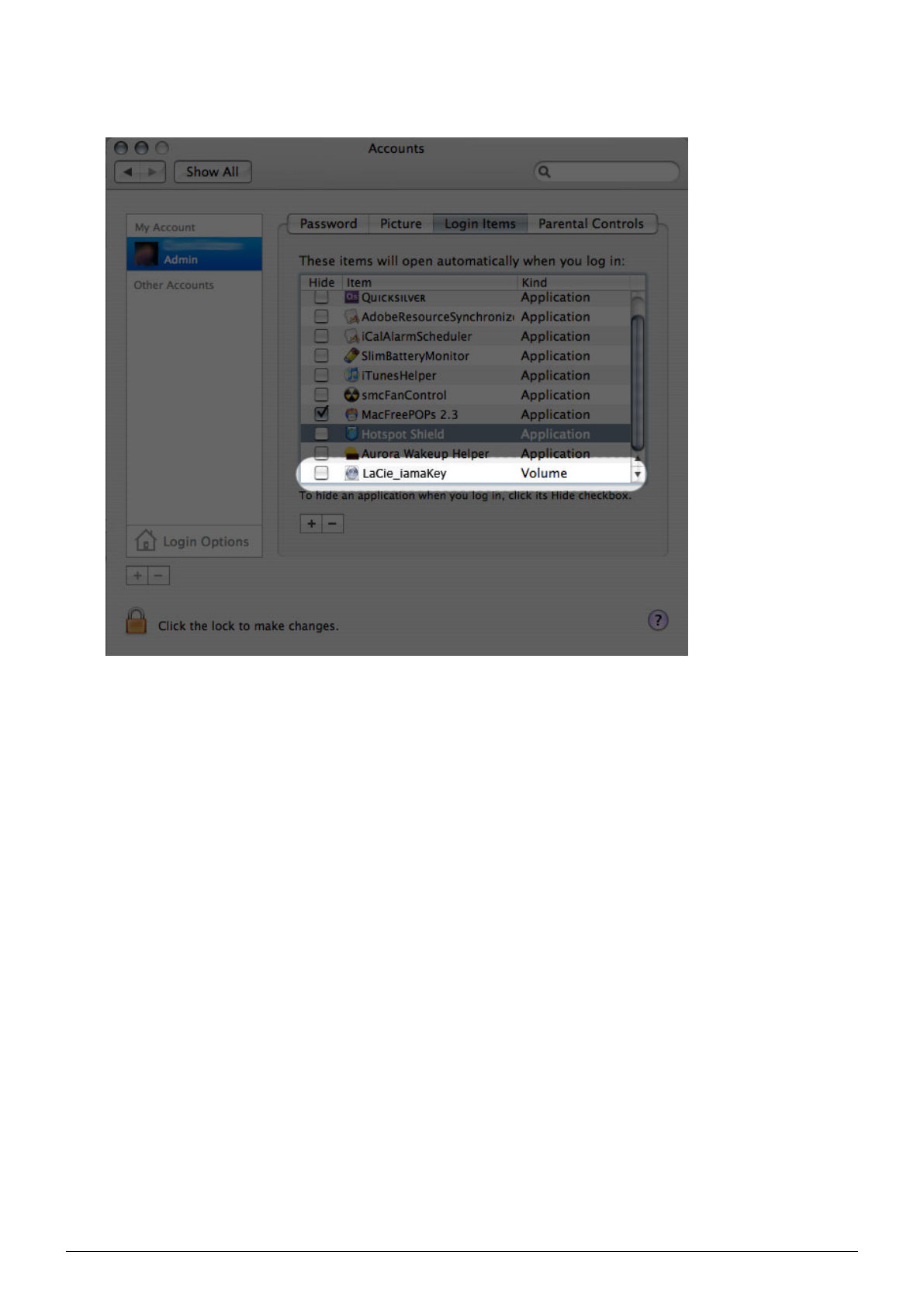
Click on the “i” sign to add a new item to the list and browse for the device. Please note that the devices2.
must be mounted in order to add them to the list.
When you log on to the Mac OS, the device(s) will automatically mount on your desktop (as long as you3.
haven't configured your Finder not to display connected servers on your desktop).
LaPlug User Manual LaCie 36
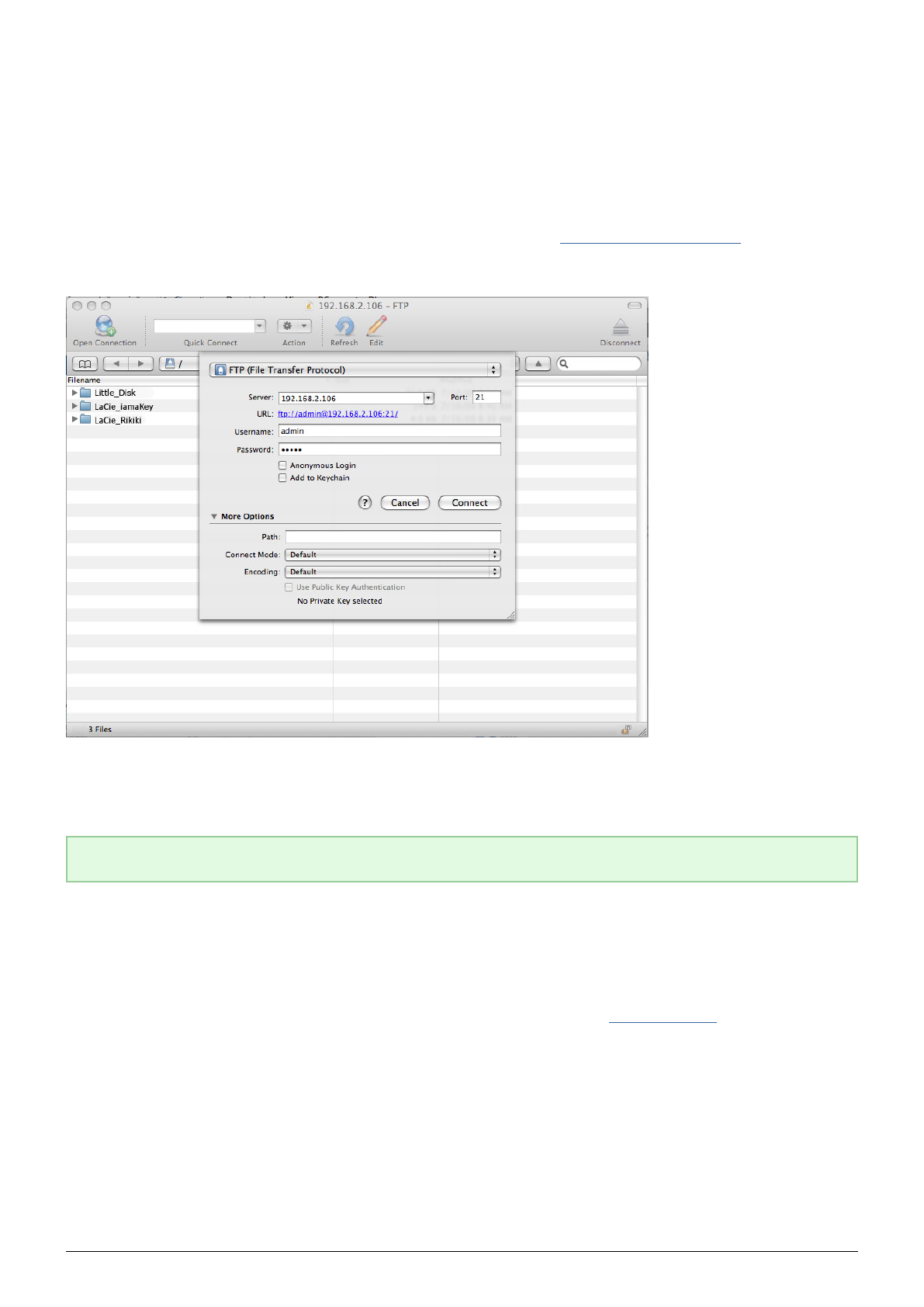
ACCESSING USB DEVICES VIA FTP
The FTP protocol is used to transfer files from one computer to another through a local network or over the
internet. This protocol allows you to exchange files with your friends or relatives securely, as only people with a
user account will have access.
The FTP service is disabled by default, so you must enable it in on the Dashboard - Network LAN page.
To connect to the LaPlug via FTP locally on the LAN, enter in your browser's or FTP client's address field:
ftp://[IP-address]
Example: ftp://192.168.10.149
Technical note: Find your device's IP address in the LaCie Network Assistant Configuration Window.
OR
ftp://@/
Example: ftp://ringo:4xtp23@LaPlug/
To login, enter your Dashboard username and password. (By default, admin/admin.)
To remotely access the drive from a computer NOT on your network, refer to Remote Access.
LaPlug User Manual LaCie 37

MEDIA SERVERS
Once you have established the network connection between your computer and the LaPlug, you can configure
your LaPlug to share files to UPnP/DLNA devices. Follow these steps:
Make sure the USB device is properly connected to the LaPlug, and that the LaPlug is connected to your1.
home network as described in Installation.
Enable Media Servers on the Dashboard (see Dashboard - General Settings).2.
Make sure that one of the attached USB devices has been assigned as the Master volume (see Dashboard -3.
Drives.
Now you will be able to play files located on USB devices connected to your LaPlug on any other4.
UPnP/DLNA-certified player/adapter (such as an XBox 360, Play Station 3, a DLNA mobile phone, etc.).
LaPlug User Manual LaCie 38
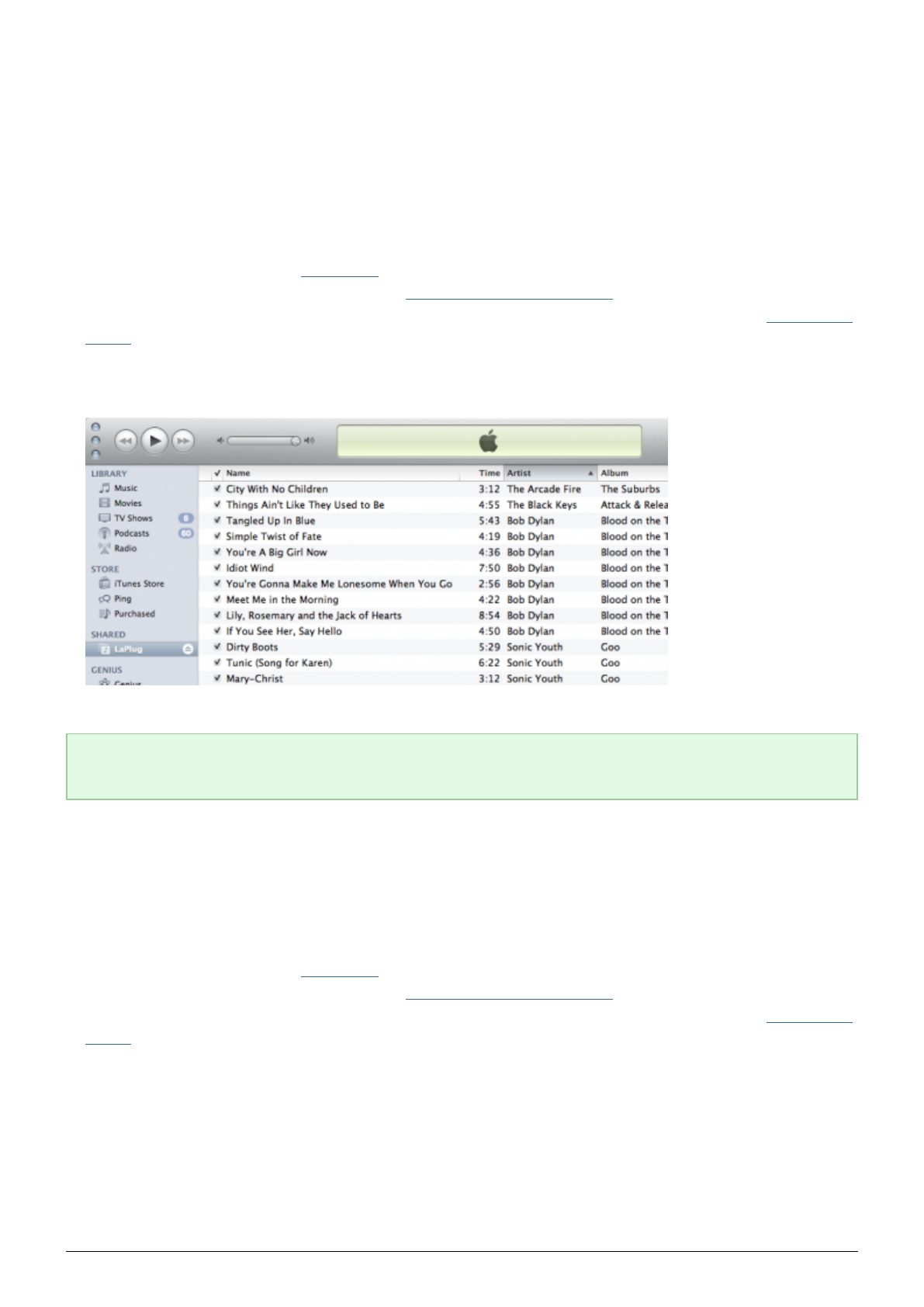
Media Servers - iTunes
The LaPlug can act as an iTunes Music server, streaming audio files to a computer on the network running
iTunes. Once configured, a playlist bearing the machine name of your LaPlug (by default LaPlug) will appear in
the Shared category within iTunes, and audio files stored on the LaPlug will be listed in this playlist. Follow these
steps:
Make sure the USB device is properly connected to the LaPlug, and that the LaPlug is connected to your1.
home network as described in Installation.
Enable Media Servers on the Dashboard (see Dashboard - General Settings).2.
Make sure that one of the attached USB devices has been assigned as the Master volume (see Dashboard -3.
Drives.
In iTunes, make sure Library sharing is enabled in Preferences > Sharing > Look for shared libraries.4.
Access the shared playlist in iTunes.5.
Technical note: The iTunes Server Service supports the following file types: .mp3, .wav, .aac, .pls, and
.m3u.
Media Servers - Windows Media Player
Once configured, Windows Media Player (WMP) can play files located on the LaPlug through the network
connection. Follow these steps:
Make sure the USB device is properly connected to the LaPlug, and that the LaPlug is connected to your1.
home network as described in Installation.
Enable Media Servers on the Dashboard (see Dashboard - General Settings).2.
Make sure that one of the attached USB devices has been assigned as the Master volume (see Dashboard -3.
Drives.
In WMP, click Organize > Manage Libraries > Music (or Video or Pictures).4.
LaPlug User Manual LaCie 39

USING BACKUP SOFTWARE
Your LaPlug is compatible with Time Machine, Windows Backup and Restore, and Genie Time Line. A USB hard
drive connected to the LaPlug can be set as a backup target for these software. Note that you will achieve much
better results with backup software if you connect the LaPlug to your network via Ethernet instead of Wi-Fi.
LaPlug User Manual LaCie 41

UPDATE PRODUCT SOFTWARE
LaCie may improve your LaPlug's software or add new features over time. See below for updating information.
Note that there are two ways of checking for new product software, from the Dashboard or from the LaCie
website.
Note also that the update procedure will not erase files saved to attached USB hard drives, but it will reset
settings to the factory defaults.
Important info: After updating product software or resetting the product to factory conditions, you must
connect the LaPlug to your network using the Ethernet cable. The reason for this is that your Wi-Fi
connection information is deleted during the update/reset.
CHECK FOR NEW SOFTWARE
Using the Dashboard
Launch the Dashboard as described in Administer the LaPlug and navigate to the System page.1.
Click the System tab, then look under Online update. If a link appears, click it to navigate to the web page2.
hosting the download.
From LaCie.com
Visit this page and download new software for your LaCie product if it is available. 1.
LaPlug User Manual LaCie 42
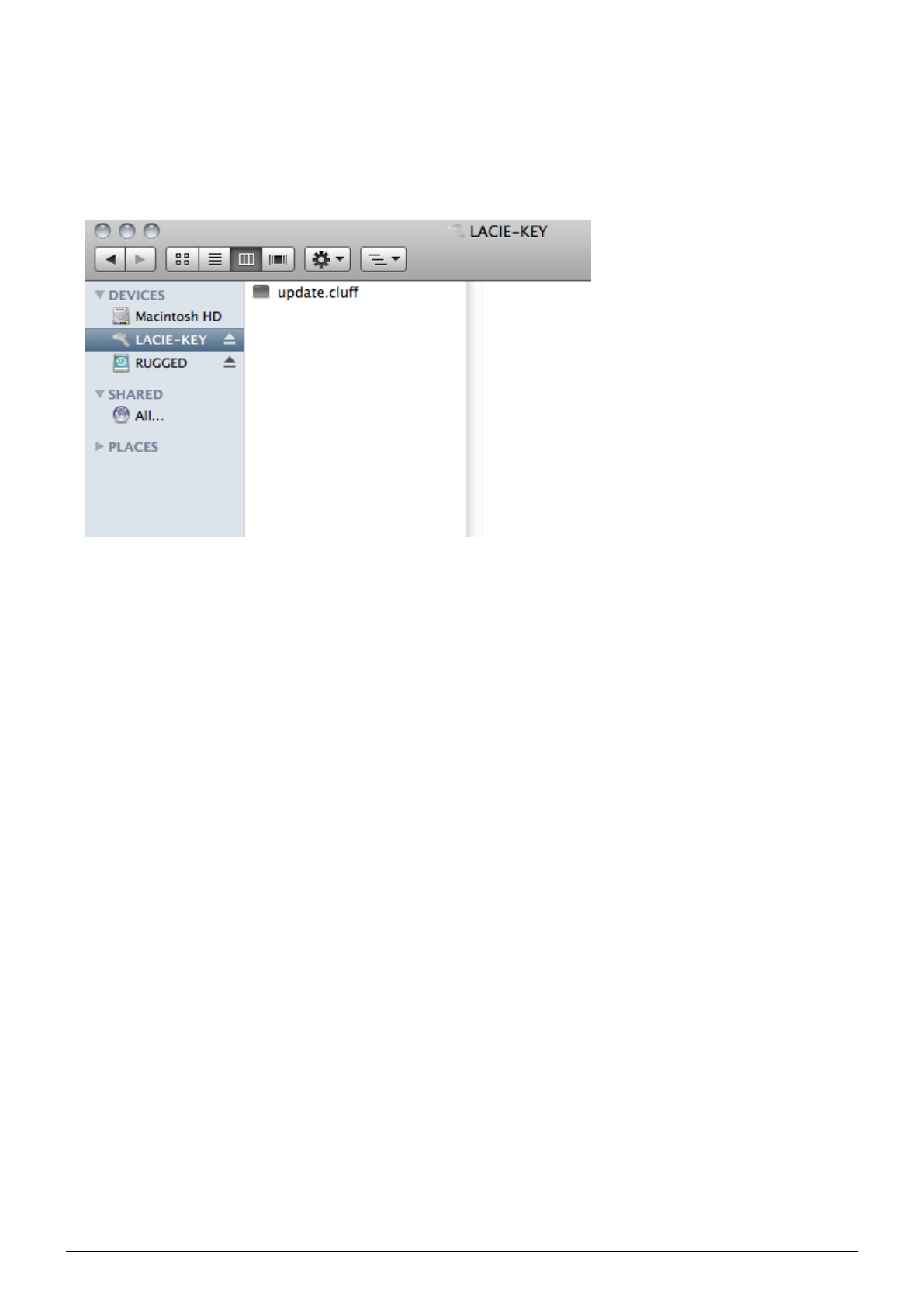
INSTALL PRODUCT SOFTWARE
Save the file you downloaded from the LaCie website onto a USB key or hard drive. Make sure it is saved to1.
the root level of the drive, ie not inside a folder (Mac users, see screenshot for example).
Make sure the LaPlug is turned off, then connect the USB key or hard drive to the LaPlug.2.
Press and hold the power button for 10 seconds. When the LED turns red, release the power button.3.
Before two seconds elapse, push and immediately release the power button once again.4.
After about two minutes, the LaPlug will reboot automatically.5.
Verify that the new software was installed by revisiting the Dashboard > Support page or the LaCie6.
Network Assistant Configuration Window.
LaPlug User Manual LaCie 43
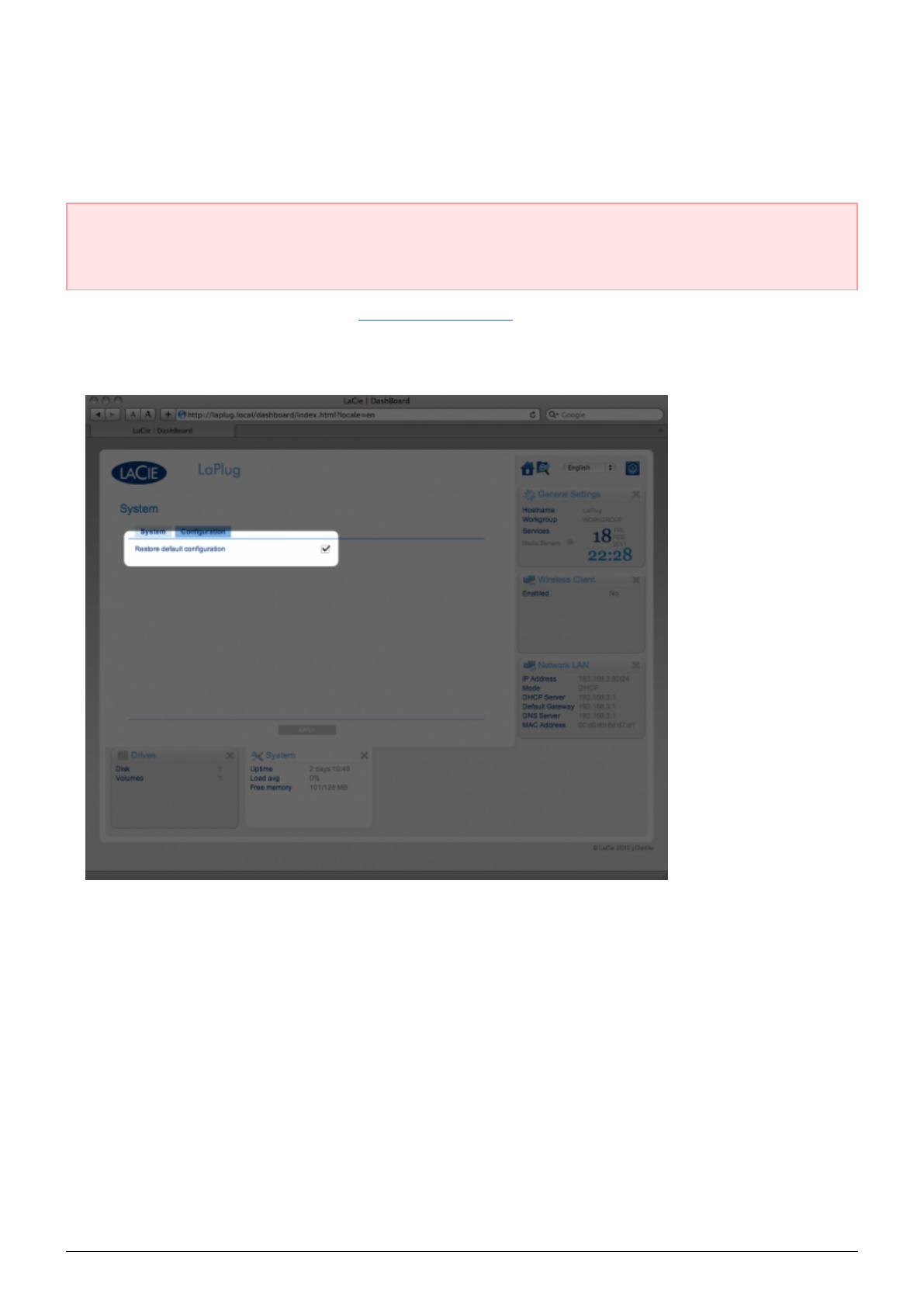
RESTORE DEFAULT CONFIGURATION
This process will revert the LaPlug to its factory settings but will not change the product software version.
Caution: Resetting the product will erase all Dashboard data such as network configuration, machine name,
and other user-generated settings. It will not change the product software version or erase files saved to
attached USB hard drives.
Launch the Dashboard as described in Administer the LaPlug and navigate to the System page.1.
Click the System tab.2.
Check the Restore default Configuration check box.3.
Click the Apply button.4.
Confirm in the popup window. The LaPlug will reboot automatically.5.
LaPlug User Manual LaCie 44

GETTING HELP
If you are having problems with your LaCie product, consult the table below for a list of available resources.
Order Source Description Location
1
Quick
Install
Guide
Concise steps to
follow for getting your
product up and
running
Printed and included in the product box, or download PDF from
the product page
2Support
Pages
Includes interactive
troubleshooting topics
for most common
problems
www.lacie.com/support/, select your product, then click the
“Troubleshooting” tab
3User
Manual
Includes common
troubleshooting topics See Troubleshooting Topics below
4Customer
Support
Create an account on
lacie.com, register
your product, and fill
out a support ticket
Create an account here:
www.lacie.com/us/mystuff/login.htm?logout&rtn=mystuff
Note: LaCie is dedicated to providing high quality products that enrich the lives of our customers. To help
LaCie offer the best customer support, we encourage you to create an account and register your product at
www.lacie.com/us/mystuff/login.htm? logout&rtn=mystuff. You can give us important feedback as well as
receive updated information on your LaCie device.
SOFTWARE UPDATES
LaCie frequently releases firmware updates to improve the functionality of products. Please check frequently for
recent updates to firmware and to LaCie Network Assistant to ensure optimum product performance. See
Update Product Software for details.
LaPlug User Manual LaCie 45

TROUBLESHOOTING TOPICS
Note: Interactive troubleshooting, a highly effective way to resolve problems with your product, is available
from www.lacie.com/support/. Select your product, then click the “Troubleshooting” tab.
Troubleshooting the Network Connection
I connected a USB drive to the USB device port, but the drive does not appear on the network
and is not listed in LaCie Network Assistant.
Q: Is the USB drive formatted?
A: USB devices must be formatted in order to be recognized by the LaPlug. Refer to your device's user manual
for details.
Q: Is the USB device or cable defective?
A: Test the device and cable by connecting it to a computer. If it mounts properly on the computer but not on
the LaPlug, try using a different USB cable. You can also try using a dedicated power supply with the drive to
rule out insufficient power as the source of the problem.
The LaPlug doesn't appear on the network.
Q: Does your computer's configuration meet the minimum system requirements?
A: Check Introduction for more information.
Q: Is the product's power supply connected and is the LED on the front of the drive on?
A: Make sure that the power supply is properly connected (see Installation for details); that the system has been
powered on by pushing the power button until the LED blinks blue; and that the outlet the power supply is
connected to is powered on or has a sufficient supply of power.
Q: Is the LED on the front of the device flickering for an inordinate period of time?
A: If the LED is flickering or will not turn on, the power supply may be defective. Please contact your LaCie
reseller or LaCie Customer Support.
Q: Are both ends of the Ethernet cable firmly connected?
A: Disconnect the Ethernet cable, wait 10 seconds and then reconnect. Ensure that the interface connectors are
properly aligned. The Ethernet cable can only be inserted one way. Make sure it is correctly oriented. Check that
the Ethernet connectors are straight and fully seated in the Ethernet ports. Make sure that you use the Ethernet
cord provided in the LaCie LaPlug box.
Q: Problems on networks without a DHCP server?
A: By default the LaCie LaPlug is configured to retrieve its IP address from a DHCP server. If your network is
managed by a DHCP server and you cannot access your LaCie LaPlug, try checking your DHCP server's log. To
get the IP address, run LaCie Network Assistant, which is located on the LaCie Storage Utilities CD-ROM. If no
DHCP server detected, the product will run APIPA to assign itself an IP address. To change this IP address, see
LaPlug User Manual LaCie 46

Dashboard > Network LAN.
LaCie Network Assistant is not working as described in this manual.
Q: Are you using an obsolete version of LaCie Network Assistant?
A: Install the latest version of LNA (see here) to ensure all features work correctly.
I've noticed a delay in accessing the shares.
Q: Are you transferring multiple files simultaneously?
A: Access to a share can slow down during simultaneous file transfers.
Troubleshooting the Multimedia Server
I've activated my LaPlug's multimedia service, but I can't access it using my UPnP/DLNA
device.
Q: Did you set one of your USB devices as the Master volume?
A: See Dashboard - Drives.
I can't configure WMP to find files on the USB device connected to the LaPlug.
Q: Did you add the LaPlug share or file inside a share to the WMP library?
A: See Media Servers - Windows Media Player.
Certain files located on the LaPlug aren't recognized by WMP.
Problem with file type compatibility?
A: WMP has certain file type restrictions. Click here for a list. Note that WMP is currently incompatible with the
MKV format.
Some files files stored on the LaPlug appear in my iTunes shared playlist, but some do not.
Q: Is the file type compatible with iTunes music server service?
A: The iTunes Server Service supports only following file types: .mp3, .wav, .aac, .pls, and .m3u. Other files will
be ignored.
I've activated my LaPlug's multimedia service, but I don't see its machine name in iTunes.
Q: Have you turned on Library Sharing in iTunes?
LaPlug User Manual LaCie 47

A: Select Preferences > Sharing > Look for shared libraries.
Some files stored on the LaPlug appear on my Xbox/PS3, but some do not.
Problem with file type compatibility?
A: Xbox and PS3 have certain file type restrictions. Click here for the PS3 list and here for the Xbox list.
LaPlug User Manual LaCie 48

PRECAUTIONS
Caution: It is essential that you use only the power supply that shipped with your product, since it is a
shielded-type power cord that meets FCC emission limits as well as to prevent interference to the nearby
radio and television reception.
Caution: Modifications not authorized by the manufacturer may void the user's authority to operate this
device.
Important info: Do not stack objects on top of the product, as they may interfere with the WiFi antenna.
Important info: Any loss, corruption or destruction of data while using a LaCie drive is the sole
responsibility of the user, and under no circumstances will LaCie be held liable for the recovery or
restoration of this data. To help prevent the loss of your data, LaCie highly recommends that you keep TWO
copies of your data; one copy on your external hard disk, for instance, and a second copy either on your
internal hard disk, another external hard disk or some other form of removable storage media. If you would
like more information on backup, please refer to our website.
Important info: Some enhancements brought to the product during its lifetime may cause discrepancies
between the information and screenshots in the manual and the actual user experience.
HEALTH AND SAFETY PRECAUTIONS
Only qualified persons are authorized to carry out maintenance on this device.
■
Read this User Manual carefully and follow the correct procedure when setting up the device.
■
Do not open the casing or attempt to disassemble or modify it. Never insert any metallic object into the casing
■
to avoid any risk of electrical shock, fire, short-circuiting or dangerous emissions. This LaCie product contains
no user-serviceable parts. If it appears to be malfunctioning, have it inspected by a qualified LaCie Technical
Support representative.
Never expose your device to rain, or use it near water, or in damp or wet conditions. Never place objects
■
containing liquids on the product, as they may spill into its openings. Doing so increases the risk of electrical
shock, short-circuiting, fire or personal injury.
GENERAL USE PRECAUTIONS
Power requirements 100-240 V~, 50-60 Hz, (supply voltage fluctuations not exceeding ± 10% of the nominal
■
and transient over-voltages according to over-voltage category II).
Do not expose the LaCie product to temperatures outside the range of 5º C to 30º C (41º F to 86º F); or to
■
operational humidity beyond 10-80%, non-condensing, or non-operating humidity beyond 5-90%,
non-condensing. Doing so may damage the LaCie product or disfigure its casing. Avoid placing your LaCie
LaPlug User Manual LaCie 49

product near a source of heat or exposing it to sunlight (even through a window). Inversely, placing your LaCie
product in an environment that is too cold may damage the unit.
Rated cooling for altitudes up to 2000 meters.
■
If your product features a power cable, always unplug it from the electrical outlet if there is a risk of lightning
■
or if it will be unused for an extended period of time. Otherwise, there is an increased risk of electrical shock,
short-circuiting or fire.
Use only the power supply shipped with the device (if applicable).
■
Do not use the LaCie product near other electrical appliances such as televisions, radios or speakers. Doing so
■
may cause interference which will adversely affect the operation of the other products.
Do not place the LaCie product near sources of magnetic interference, such as computer displays, televisions
■
or speakers. Magnetic interference can affect the operation and stability of your LaCie product.
Never use excessive force on your LaCie product. If you detect a problem, consult the troubleshooting section
■
in this manual.
Protect your LaCie product from excessive exposure to dust during use or storage. Dust can build up inside the
■
device, increasing the risk of damage or malfunction.
Never use benzene, paint thinners, detergent or other chemical products to clean the outside of the LaCie
■
product. Such products will disfigure and discolor the casing. Instead, use a soft, dry cloth to wipe the device.
LaPlug User Manual LaCie 50

WARRANTY INFORMATION
LaCie offers first-rate service and support through our generous three-tiered warranty policy. Our 1-, 2- and
3-year policies include comprehensive, complimentary web-based resources, expert in-house technical support,
and worldwide repair and/or replacement coverage. To benefit from this warranty, please contact LaCie Support
at www.lacie.com/us/support/index.htm where you can find online support and contact information. You may
also contact representatives at the original point of purchase who will be able to help guide you. Warranties
vary depending on the product:
1-year limited - consumer level
■
2-year limited - prosumer level
■
3-year limited - professional level
■
5-year limited - enterprise class level (more information: www.lacie.com/us/more/?id=10100 )
■
Optional 3-year LaCie Advance Care Option (sold separately)1
■
For a detailed list of product warranties, go to www.lacie.com/products/warranty.htm.
LACIE LIMITED WARRANTY POLICY
LaCie (“LaCie”) warrants, to the original purchaser, that this equipment shall be free of defects in materials and
workmanship for a period of one (1), two (2), three (3), or five (5) years, depending on the model, from LaCie's
date of original shipment when the equipment is used normally and is properly serviced when needed. If you
discover a defect covered by the warranty set forth above, your sole and exclusive remedy will be for LaCie, in
its sole discretion to (i) repair or replace the product at no charge to you; or, if a repaired unit or replacement
product is not available, (ii) to refund the current market value of your product. You acknowledge and agree
that replacement product, at the sole option of LaCie, may be a new product or a remanufactured product. In
order to receive the remedy set forth above, you must return the product during the warranty period and
include with each returned product (i) a copy of your original purchase invoice to verify your warranty; (ii) a
Return Material Authorization number; (iii) your name, address and telephone number; (iv) a copy of the bill of
sale bearing the appropriate LaCie serial numbers as proof of date of original retail purchase; and (v) a
description of the problem. The customer must pay all transportation costs for a returned product. The product
will need to be returned to LaCie within the country of original retail purchase. This warranty applies only to
hardware products; LaCie software, media, and manuals are licensed and warranted pursuant to separate
written agreement. This warranty does not apply if the product has been misused or has been damaged by
accident, abuse, misuse, or misapplication; if it has been modified without permission of LaCie; or if any LaCie
serial number has been removed or defaced. If a customer has purchased a LaCie Advance Care Option (ACO)
to go with this equipment, the ACO shall be valid for three (3) years from activation.
EXCEPT FOR THE LIMITED WARRANTY SET FORTH ABOVE, ALL PRODUCTS ARE SOLD “AS IS” AND LACIE
EXPRESSLY DISCLAIMS ALL WARRANTIES OF ANY KIND, WHETHER EXPRESS, IMPLIED OR STATUTORY,
INCLUDING THE IMPLIED WARRANTIES OF MERCHANTABILITY, NONINFRINGEMENT AND FITNESS FOR A
PARTICULAR PURPOSE. WITHOUT FURTHER LIMITING THE GENERALITY OF THE FOREGOING, DOES NOT
WARRANT (1) THE PERFORMANCE OR RESULTS OBTAINED FROM USING THIS PRODUCT, (2) THAT THE PRODUCT
IS APPROPRIATE FOR THE CUSTOMER'S PURPOSES, (3) THE MANUAL IS ERROR FREE, OR (4) THAT NO DATA WILL
BE LOST WHILE USING THE PRODUCT. THE ENTIRE RISK AS TO THE RESULTS AND PERFORMANCE IS ASSUMED
BY THE CUSTOMER. THE WARRANTY AND REMEDIES SET FORTH ABOVE ARE EXCLUSIVE AND IN LIEU OF ALL
OTHERS, ORAL OR WRITTEN, EXPRESS OR IMPLIED.
EXCLUSIONS AND LIMITATIONS
This Limited Warranty applies only to hardware products manufactured by or for LaCie that can be identified by
LaPlug User Manual LaCie 51

the “LaCie” trademark, trade name, or logo affixed to them. The Limited Warranty does not apply to any
non-LaCie hardware products or any software, even if packaged or sold with LaCie hardware. Manufacturers,
suppliers, or publishers, other than LaCie, may provide their own warranties to the end user purchaser, but
LaCie, in so far as permitted by law, provides their products “as is”. Software distributed by LaCie with or
without the LaCie brand name (including, but not limited to system software) is not covered under this Limited
Warranty. Refer to the licensing agreement accompanying the software for details of your rights with respect to
its use.
LaCie does not warrant that the operation of the product will be uninterrupted or error-free. LaCie is not
responsible for damage arising from failure to follow instructions relating to the product's use. This warranty
does not apply: (a) to consumable parts, unless damage has occurred due to a defect in materials or
workmanship; (b) to cosmetic damage, including but not limited to scratches, dents and broken plastic on ports;
© to damage caused by use with non-LaCie products; (d) to damage caused by accident, abuse, misuse, flood,
fire, earthquake or other external causes; (e) to damage caused by operating the product outside the permitted
or intended uses described by LaCie; (f) to damage caused by service (including upgrades and expansions)
performed by anyone who is not a representative of LaCie or a LaCie Authorized Service Provider; (g) to a
product or part that has been modified to alter functionality or capability without the written permission of LaCie;
or (h) if any LaCie serial number on the product has been removed or defaced.
No LaCie dealer, agent, or employee is authorized to make any modification, extension, or addition to this
warranty.
Any loss, corruption or destruction of data while using a LaCie drive is the sole responsibility of the user, and
under no circumstances will LaCie be held liable for the recovery or restoration of this data. To help prevent the
loss of your data, LaCie highly recommends that you keep TWO copies of your data; one copy on your external
hard disk, for instance, and a second copy either on your internal hard disk, another external hard disk or some
other form of removable storage media. LaCie offers a complete line of CD and DVD drives. If you would like
more information on backup, please refer to our website.
LACIE IS NOT RESPONSIBLE FOR SPECIAL, INCIDENTAL, OR CONSEQUENTIAL DAMAGES RESULTING FROM ANY
BREACH OF WARRANTY, OR UNDER ANY LEGAL THEORY, INCLUDING LOST PROFITS, DOWNTIME, GOODWILL,
DAMAGE TO OR REPLACEMENT OF EQUIPMENT AND PROPERTY, AND ANY COSTS OF RECOVERING,
REPROGRAMMING, OR REPRODUCING ANY PROGRAM OR DATA STORED IN OR USED WITH LACIE PRODUCTS
EVEN IF IT HAS BEEN ADVISED OF THE POSSIBILITY OF SUCH DAMAGES.
Some states do not allow the exclusion or limitation of implied warranties or liability for incidental or
consequential damages, so the above limitation or exclusion may not apply to you. This warranty gives you
specific legal rights, and you may have other rights, which vary from state to state.
Your opening of your package, your use of the product, or your return of the enclosed Registration Card
acknowledges that you have read and agree to the terms of this Agreement. You further agree that it is the
complete and exclusive state of the agreement between us and supersedes any proposal or prior agreement,
oral or written, and any other communications between us relating to the subject matter of this Agreement.
Read carefully all information related to warranty and precautions of use of your new LaCie product in the user's
manual. For products purchased in the United States, you may contact LaCie at 22985 NW Evergreen Parkway,
Hillsboro, Oregon 97124. Email: sales@lacie.com. Website: www.lacie.com. Customer service: 503-844-4503.
SERVICE DOA
On rare occasions, a newly purchased LaCie product may be delivered in non-working order. We are working to
avoid these issues, but unfortunately, these situations may arise from time to time. Within the 15 calendar days
of purchase, should you experience an issue with your new LaCie product, we ask you to return the product to
the place where it was originally bought. You will be required to give a proof of purchase.
ADVANCE CARE OPTION
All products with a 3-year warranty can benefit from the LaCie Advance Care Option. This option can be
LaPlug User Manual LaCie 52

purchased separately online within 30 days of the purchase date of your LaCie product and you will be asked to
provide us with your proof of purchase. The Advance Care Option does not extend the original warranty period.
Under this warranty, LaCie will swap out a product without it needing to be returned first for minimal
interruption of your workflow. LaCie will replace part of the product or all of it, depending on our screening
process. You might receive a reconditioned product in non-retail packaging. LaCie will cover all freight costs.
The product's Serial Number must be submitted on the LaCie website first. To secure the Advance Care Option,
your credit card number must be submitted as well. Should the product not be returned within 21 calendar days
of the replacement product's shipment date, you will be charged for the full value of a new comparable product.
LaCie can only provide this optional warranty in countries where there is a local LaCie office.1
CUSTOMER WARNING
Please be sure to back up your data before returning your drive to LaCie for repair. LaCie cannot under any
circumstances guarantee the integrity of data remaining on a returned drive. We make no provisions for data
recovery and cannot be held liable for any data loss on drives or media returned to LaCie.
All products returned to LaCie must be securely packaged in their original box and shipped with postage prepaid,
except for Products registered under the Advance Care Option.
1 The Advance Care Option is offered as an option depending on the geographic zone, limited to the following
zones: Continental USA, Canada, UK, Ireland, Norway, Sweden, Finland, Denmark, Germany, Austria, Switzerland,
Netherlands, Belgium, France, Spain, Italy and Australia.
LaPlug User Manual LaCie 53

LEGAL INFO
COPYRIGHTS
Copyright © 2011 LaCie. All rights reserved. No part of this publication may be reproduced, stored in a retrieval
system, or transmitted in any form or by any means, electronic, mechanical, photocopying, recording or
otherwise, without the prior written consent of LaCie.
CHANGES
The material in this document is for information only and subject to change without notice. While reasonable
efforts have been made in the preparation of this document to assure its accuracy, LaCie assumes no liability
resulting from errors or omissions in this document, or from the use of the information contained herein. LaCie
reserves the right to make changes or revisions in the product design or the product manual without reservation
and without obligation to notify any person of such revisions and changes.
FEDERAL COMMUNICATION COMMISSION INTERFERENCE STATEMENT
This equipment has been tested and found to comply with the limits for a Class B digital device, pursuant to Part
15 of the FCC Rules. These limits are designed to provide reasonable protection against harmful interference in
a residential installation. This equipment generates, uses and can radiate radio frequency energy and, if not
installed and used in accordance with the instructions, may cause harmful interference to radio communications.
However, there is no guarantee that interference will not occur in a particular installation. If this equipment does
cause harmful interference to radio or television reception, which can be determined by turning the equipment
off and on, the user is encouraged to try to correct the interference by one of the following measures:
Reorient or relocate the receiving antenna.1.
Increase the separation between the equipment and receiver.2.
Connect the equipment into an outlet on a circuit different from that to which the receiver is connected.3.
Consult the dealer or an experienced radio/TV technician for help.4.
FCC Caution: Any changes or modifications not expressly approved by the party responsible for compliance
could void the user's authority to operate this equipment.
This device complies with Part 15 of the FCC Rules. Operation is subject to the following two conditions: (1) This
device may not cause harmful interference, and (2) this device must accept any interference received, including
interference that may cause undesired operation.
Important info: FCC Radiation Exposure Statement: This equipment complies with FCC radiation
exposure limits set forth for an uncontrolled environment. This equipment should be installed and operated
with minimum distance 20 cm between the radiator & your body.
This transmitter must not be co-located or operating in conjunction with any other antenna or transmitter.
The availability of some specific channels and/or operational frequency bands are country dependent and are
firmware programmed at the factory to match the intended destination. The firmware setting is not accessible
by the end user.
LaPlug User Manual LaCie 54

WEE
This symbol on the product or on its packaging indicates that this product must not be disposed of
with your other household waste. Instead, it is your responsibility to dispose of your waste
equipment by handing it over to a designed collection point for the recycling of waste electrical and
electronic equipment. The separate collection and recycling of your waste equipment at the time of
disposal will help to conserve natural resources and ensure that it is recycled in a manner that
protects human health and the environment. For more information about where you can drop off your waste
equipment for recycling, please contact your local city office, your household waste disposal service, or the shop
where you purchased the product.
TRADEMARKS
Apple, Mac, Time Machine, and Macintosh are registered trademarks of Apple Computer, Inc. Microsoft,
Windows XP, Windows Vista, and Windows 7 are registered trademarks of Microsoft Corporation. Other
trademarks mentioned in this manual are the property of their respective owners.
LICENCES AND FREE SOFTWARE
Your LaCie product ships with copyrighted software that are licensed under the GPL, AFL, Apache, Apple, BSD,
GNU LGPL, MIT, OpenLDAP, OpenSSL, PHP, Python, and Creative Common. It also includes free software, the
source code for which can be downloaded from the LaCie website: www.lacie.com/support/
© 2007-2008, Thomas BERNARD. © 2006 Allan Saddi allan@saddi.com © 2004, Jan Kneschke, incremental. ©
2001-2006, Patrick K. O’Brien and Contributors. © 2003-2009 Stuart Bishop stuart@stuartbishop.net. © 2006
Kirill Simonov. © 1996-2006 Julian R Seward. © 2004, 2005 Darren Tucker. All rights reserved. © 1997-2008
University of Cambridge. All rights reserved. © 2007-2008, Google Inc. All rights reserved. © 1990-2003
Sleepycat Software. All rights reserved. © 1995-2004 Jean-loup Gailly and Mark Adler. © 2004 Micah Dowty. ®
1997-2006 by Secret Labs AB ® 1995-2006 by Fredrik Lundh. © 1988,1990,1993,1994 by Paul Vixie. ©
2007-2009 Charles du Jeu.
This list of licenses can evolve over time and can be found on the user interface under the heading “Credits.”
CANADA COMPLIANCE STATEMENT
This Class A digital apparatus meets all requirements of the Canadian Interference-Causing Equipment
Regulations.
JAPAN COMPLIANCE STATEMENT
This is a Class A product based on the standard of the Voluntary Control Council for Interference from
Information Technology Equipment (VCCI). If this is used near a radio/TV receiver, it may cause radio
interference. Install the equipment according to the manual.
LaPlug User Manual LaCie 55

MANUFACTURER'S DECLARATION FOR CE CERTIFICATION
We, LaCie, solemnly declare that, under our sole responsibility, this product is in compliance with the
essential requirements and other relevant provisions of the European directives 1999/5/EC (R&TTE),
2004/108/EC (EMC), and 2006/95/EC (Safety). The product fulfills the standards and/or documents
below:
EN301489-1 v1.8.1 (2008 – 04)
EN301489-17 v2.1.1 (2009 – 05)
EN300328 v1.7.1 (2006-10)
EN 55022: 2006 + A1 2007
EN 61000-3-2: 2006
EN 61000-3-3: 2008
EN 55024: 1998+A1: 2001+A2: 2003
EN61000-4-2: 2008 ED. 2.0
EN61000-4-3: 2006 + A1: 2007 ED. 3.0
EN61000-4-4: 2004 ED. 2.0
EN61000-4-5: 2005 ED. 2.0
EN61000-4-6: 2008 ED. 3.0
EN61000-4-8: 2009 ED. 2.0
EN61000-4-11: 2004 ED. 2.0
EN60950-1 :2006 + A11: 2009
LaPlug User Manual LaCie 56

GLOSSARY
802.11b/g/n - The number 802.11 is the IEEE (Institute of Electrical and Electronics Engineers) term for the
wireless signal on a land area network (WLAN). The letters that follow indicate the levels of strength. The
following lists the maximum throughputs for b and g:
b = 11 Mb/s
■
g = 54 Mb/s
■
n is the most recent protocol:
n = well over 50 Mb/s
■
AFP (Apple Filing Protocol) - Similar to SMB/CIFS and NFS, AFP is a protocol used for requests over a network.
Requests could mean accessing shared files, volumes, and devices (such as printers). AFP is used for
Apple-based systems, Mac OS 9 and X.
DHCP (Dynamic Host Configuration Protocol) - A computer requires an identity when it connects to a
network, otherwise access to the Internet as well as company or home servers will not be possible. That identity
is called an IP (Internet Protocol) address, which may be enabled manually (Static IP) in the operating system
network settings or assigned by a network management device, such as a DHCP device. Though a generic term,
the device could be a server or an active switch, as found in business environments; or, a cable or DSL modem
offered by an Internet provider. The LaCie product has the ability to assign IP addresses dynamically, which
means it can be configured as a DHCP server. An example of an IP address is 192.168.10.1
DHCP Server Range Start IP/Range End IP - The range of addresses that a DHCP server may assign to the
attached systems.
DLNA™ (Digital Living Network Alliance) - A standard (based on UPnP) widely embraced by consumer
electronic manufacturers to allow entertainment devices within the home to share movies, music, and photos
across a home network.
DNS (Domain Name System or Domain Name Server) - All email and web addresses are domain names.
Every web site and email account has a specific place within a server that has a unique IP address (such as
192.168.54.25, IPv4; or 2001:db8:1f70::999:de8:7648:6e8, IPv6). However, when we launch a favorite browser
to buy a new hard drive or send an email, we do not type lengthy, hard to remember numerical addresses.
Instead, we use company names, www.lacie.com, or email addresses, sales@lacie.com. The domain names in
these examples are “lacie.com” or ”@lacie.com”. The server manages the tie between the IP address it requires
for a network identity and the domain name for communication.
DSL (Digital Subscriber Line) - Broadband data transmitted digitally over telephone wires. The local
telephone company provides a service that includes Internet, telephone, and, for some, cable television. For
access to the Internet, telephone companies generally provide an adapter or DSL modem for connection to a
computer via Ethernet.
Dynamic DNS - This moves DNS hosting a bit further as it provides access to domain names hosted on servers
with varying (hence, dynamic) IP addresses. This means that web sites are not forced to maintain a single IP
address, but can be managed within a network that uses DHCP to assign an identity. The Dynamic DNS host is
smart enough to read the domain name and find the IP address to which it belongs. Dynamic DNS is a great tool
for accessing home network servers, such as the LaCie product, from anywhere outside the home.
Dynamic Port Forwarding - Allows applications to use SOCKS servers on local ports for network
communication and Internet access. This can be very convenient as it will avoid having to configure port
forwarding each time an application is used. The SOCKS is configured on a server to route traffic while the
application, such as a web browser, is assigned a SOCKS in its preferences.
External Port - This port deals with requests outside the LAN, working with the NAT (network address
translation) to convert external IP addresses and port numbers to addresses that will be accepted inside the
network.
Firewall - One or more programs that act in concert with the gateway server to protect the computers and
systems within a network.
LaPlug User Manual LaCie 57

Frame - A frame comprises all the data that is sent between network points, including the addressing and
network protocol information.
FTP (File Transfer Protocol) - A protocol used to transfer and exchange files over networks that use TCP/IP.
With FTP, one person can copy files into a folder within an FTP server for others to access. Permissions are
generally set so that anyone seeking to access the files must enter a username and password.
FTP Server - A server that acts as the “host” for FTP transfers and exchanges. A server, such as the LaCie
product, can enable FTP access to files stored on its volume(s). The LaCie product can act as an FTP server,
allowing the user, or friends and family, to access its files or volumes by Internet hyperlinks. The base addresses
are: ftp://IP-address, such as ftp://192.168.15.24; and ftp://username:password@/.
Gateway - See Network Gateway
HTTP (Hypertext Transfer Protocol) - The most common protocol for the World Wide Web (the “www” in
web addresses). HTTP is a command that aids in defining the messaging for Web servers and browsing,
initiating the request to a particular address.
HTTPS (Hypertext Transfer Protocol Secure) - A secure level of HTTP that uses SSL protocol for encryption
and identification. Very often seen with online financial websites or when making a purchase on the Internet.
HTTPS Certificate - A digital certificate verifies the identity of a web site or user. When a user logs onto the
site, the browser will automatically accept the certificate and indicate that the site is secure (often graphically
represented by a lock). HTTPS certificates may be purchased and/or generated from many online vendors.
ICMP (Internet Control Message Protocol) - Another level of address communication, along with TCP and
UDP. However, this level is generally not used to send and receive messages between servers or computers.
ICMP is implemented mostly for error messages, such as a Web site being unavailable, or the popular ping
feature used to search for other IP addresses on a network.
Internal Port - This port deals with requests inside the LAN, such as accessing files or sending emails.
Internet Provider - Broadband Internet service is available with a cable modem provided by the local cable
provider. The cable modem is linked to the computer via an Ethernet cable.
IP Address (Internet Protocol) - Each computer must have at least one unique identity to engage in a form
of network communication. The IP address has multiple layers that allow a computer to send and receive data,
whether looking for web sites on the Internet from home or sending e-mail to a colleague at work.
IPv4 - The most common form of network addressing used today, IPv4 is 32-bit. The format is easily
recognizable as xxx.xxx.xxx.xxx, where each “x” only represents the maximum digits in each field between
periods. An IPv4 address can be 192.168.1.1 or 84.22.291.652. The maximum number of combinations reaches
well over four billion. Even so, due to a world that has become dependent on Internet communication, IPv4
addressing is becoming difficult to maintain.
IPv6 - To combat the seeming inevitability of IPv4 addressing reaching its worldwide limit, IPv6 now offers much
larger 128-bit addressing. Examples of the longer length are often seen as
xxxx:xxxx:xxx:xxxx:xxx:xxxx:xxxx:xxxx, where “x” can be a letter or a number. However, it is not necessary to
use four digits in all eight fields and the address can be truncated when heavily populated with zeros. IPv6 is
flexible in understanding the address even when cutting back on leading zero digits or using a double colon to
remove them altogether. The address below is an example of the same network identity in all its permutations:
2001:0f34:0000:0000:0000:0000:2002:04fe
2001:f34:000:000:000:000:2002:4fe
2001:f34:00:00:00:00:2002:4fe
2001:f34:0:0:0:0:2002:4fe
2001:f34::2002:4fe
Note that the double colons can be used to replace whole fields that contain only zeros.
ISP (Internet Service Provider) - The service that has installed a cable or DSL modem in a home or business
for access to the Internet.
iTunes™ Server - iTunes libraries can be shared over a local network via a computer, network disk, or network
device that acts as the iTunes Server. The protocol is used to detect libraries on the computer, network disk, or
network device and stream playlists to anyone who requests them. The function must also be enabled on each
LaPlug User Manual LaCie 58

computer that runs iTunes.
iTunes™ Scan Interval - Periodic scans of the shared music libraries for updates. For example, a LaCie
network device automatically performs an iTunes once every 24 hours.
LAN (Local Area Network) - A network within a small or limited geography, such as an office, a school, or a
home.
MAC Address (Media Access Control) - A unique identifier assigned by the manufacturer of a computer's
network interface card. Though it has a different naming structure, a MAC address works with the IP address for
network communication. There are many layers of network communication but, as an oversimplification, the
MAC address supports the hardware aspect while the IP deals with the software implementation. An IP address
can change while a MAC address is almost always fixed. A MAC address can generally be found in the operating
system network settings, also referred to as an ethernet address, hardware address, adapter address, or
physical address. The naming structure can be listed in two ways:
MM:MM:MM:SS:SS:SS or MM-MM-MM-SS-SS-SS
The “M” half of the address represents code used to identify the manufacturer of the network interface while
the “S” half is a serial number. For example, a common manufacturer “M” prefix is, 00A0C9 since it represents
Intel®. A full MAC address example is 00:23:df:99:5e:2a, with 00:23:df pointing to Apple as the manufacturer.
MAC Address Cloning - Internet service providers (ISP) may limit the amount of network connections by
counting MAC addresses. Upon seeing more than an arbitrary number of MAC addresses on your home network,
access will be denied to additional devices. MAC address cloning enables a router or network device to create a
single MAC address for the ISP to see while it manages the computers that are attached via Ethernet or Wi-Fi.
NAT (Network Address Translation) - A router will take addresses that come from public servers and
translate them to addresses that are acceptable to the private network. This is helpful for reducing the number
of IP addresses on a network or directing welcome traffic into a private network while dismissing unwanted
visitors.
NAT-PMP (Network Address Translation-Port Mapping Protocol) - Taking port forwarding a step further,
this allows users in a private network to automate network address translation by port number. Addresses
outside the private network include a port number that mark them as acceptable. NAT-PMP converts “good”
traffic into acceptable IP address within the system.
Netmask - Also known as the subnetwork. A subnet address is part of the IP address information, generally
placing a network geography onto one or more computers. That is, everyone with a certain subnet address is
hosted or attached to a specific server. A subnet mask has an address listing similar in form to IPv4. A common
subnet mask (as it is called in the operating system preferences) is: 255.255.255.0.
Network Gateway - Capable of operating in software, hardware, or a combination of the two, a network
gateway assists in enabling communication between networks with different protocols. Often, the network
gateway is the Internet access device (such as a broadband router) provided by the ISP. An example would be
one network that is using TCP/IP, while a second runs AppleTalk and a third, UDP. The network gateway assures
that the translation process between them is transparent to the user.
NTP Server (Network Time Protocol) - A protocol used to synchronize the time for computers that reside on
the same network. Public NTP servers are also available on the Internet.
Port Forwarding - Since a port number is part of a network address, it is possible to target specific IP
addresses by their port numbers. This way, remote computers or devices with IP addresses can shake hands
with a particular address on a LAN. A real world example is a Playstation®3 being used for an online game. That
particular game may demand a specific IP address and port number for its network communication.
Port Number - Another layer of network addressing that works with protocols such as TCP/IP or UDP/IP. A port
number is represented by a number ranging from 0 to 65535. Under normal conditions, a user does not have to
worry about port numbers for network communication since they remain layers in the addressing protocol.
However, for advanced use, some port numbers may have to be managed or specifically opened due to the
demands of hardware, software, or firewalls. For example, it may be necessary to open Port 80 in order to play a
video game online.
Print Server - A network device that is connected to one or more printers and to client computers over a local
network. It can accept print jobs from the computers and send them to the appropriate printer(s).
Proxy Server - A special server that aids in client-client, client-server, and/or server-server communications. A
LaPlug User Manual LaCie 59

common example is a web server that acts as the portal for a company's traffic to the Internet. Each client has
the server IP address listed as the proxy server in their network settings in order to access the Internet or use
email.
Remote Access - Accessing data or managing a server or workstation from a separate system or network. The
remote access feature on your LaCie product includes the creation of a hostname (essentially, a unique web
address name, such as www.lacieNAS.dyndns.org) that will enable easy management and access to data stored
on the device from a separate network.
SAMBA - Another name for SMB. See SMB/CIFS
SMB/CIFS (Server Message Block/Common Internet File System) - There are many protocols that a
network must implement to assure proper communication between systems, servers, and devices (such as
printers). In normal operation, a computer requests a shared file or device managed by a server and the server
responds to the demand. SMB/CIFS (also called “Samba”) is a protocol that targets the level in which
applications will ask to share a file or device. SMB/CIFS is compatible with Linux, Mac, and Windows, meaning
that all three operating systems may reside on the same shared network of servers and devices.
SMTP Server (Simple Mail Transfer Protocol) - A networking and Internet standard for email
communication via IP addressing. SMTP is used for outgoing mail, often using port 25.
SOCKS (for Sockets) - A protocol that enables client-client and/or client-server communication via a proxy
server. For example, two co-workers want to exchange information but one is blocked due to a firewall. Using
the SOCKS Internet protocol, a proxy server will allow them to communicate.
SSID (Server Set Identifier) - The network name of the wireless access point. While an SSID contains no
built-in security protocol, it can act as a password when kept hidden from outside traffic.
Static IP (Internet Protocol) - As opposed to DHCP, where the IP address on a computer may change based
upon how the server or router manages network identities, a static IP rarely varies.
Static Port Forwarding - Configuring port forwarding to handle traffic through an IP address that does not
change. A static address must be configured on a system in order to properly configure static port forwarding.
TCP/IP (Transport Control Protocol/Internet Protocol) - TCP is another layer of communication between
the Internet and, within companies or organizations, the Intranet. The TCP breaks down the information that is
being sent then puts it back together on the receiving end. The IP layer makes certain that the packets reach
the correct address.
Time Machine™ - A backup utility for computers using Mac OS X. Using incremental backups, Time Machine
offers a simple interface to back up Apple computers on network or desktop attached storage devices. Users
can retrieve single or numerous files that have been periodically saved.
TKIP (Temporal Key Integrity Protocol) - An enhanced version of WEP security, TKIP was created to
strengthen hardware that was only compatible with WEP. It adds additional security encryption to the existing
WEP.
TLS (Transport Layer Security) - An encryption protocol for Internet communication that is stronger than SSL.
UDP/IP (User or Universal Datagram Protocol/Internet Protocol) - An alternative network protocol to TCP
that does not have the ability to reorder or assemble packages of data sent via the Internet. UDP generally
sends the message packets and relies upon the user software to put them in order. UDP is good for cutting back
on processing with smaller files, since there is little to reassemble at the destination address. IP makes certain
that the correct address receives the data.
UPnP™/IGD (Universal Plug and Play/Internet Gateway Device) - UPnP enables devices to share media
and data on a network. UPnP devices are “plug-and-play” since they automatically announce their address and
supported services once connected to a network. Other systems on the network that recognize those services
may immediately begin sharing media with the device. UPnP is very popular with gaming systems such as the
Playstation 3 or the Xbox.
WLAN (Wireless Land Area Network) - Similar to a LAN but within the network of a wireless access point.
WEP (Wired Equivalent Privacy) - A security protocol for WLANs. Encrypting data over radio waves, WEP is a
security standard that was ported from LAN to WLAN. WEP is not the strongest level of protection for a wireless
network since it does not include all layers of network addressing. WEP will protect the data and physical layers
of an address.
LaPlug User Manual LaCie 60

WEP Key - The security code for a Wi-Fi access point using WEP. It is a series of hexadecimal digits (0-9 and
A-F).
WEP Key ID - WEP encryption allows four keys. The user and the wireless access point start with the base WEP
Key, then add one of the four WEP Key IDs to extend the characters and strengthen security.
WPA (Wi-Fi Protected Access) - A slightly stronger wireless security protocol than WEP.
WPA2 (Wi-Fi Protected Access 2) - Higher level of wireless security than WPA.
WPA PSK (Wi-Fi Protected Access, Pre-Shared Key) - A “key”, or password, that is shared between a
wireless access point and the members of the WLAN. In this case, the PSK uses WPA encryption for security.
LaPlug User Manual LaCie 61
